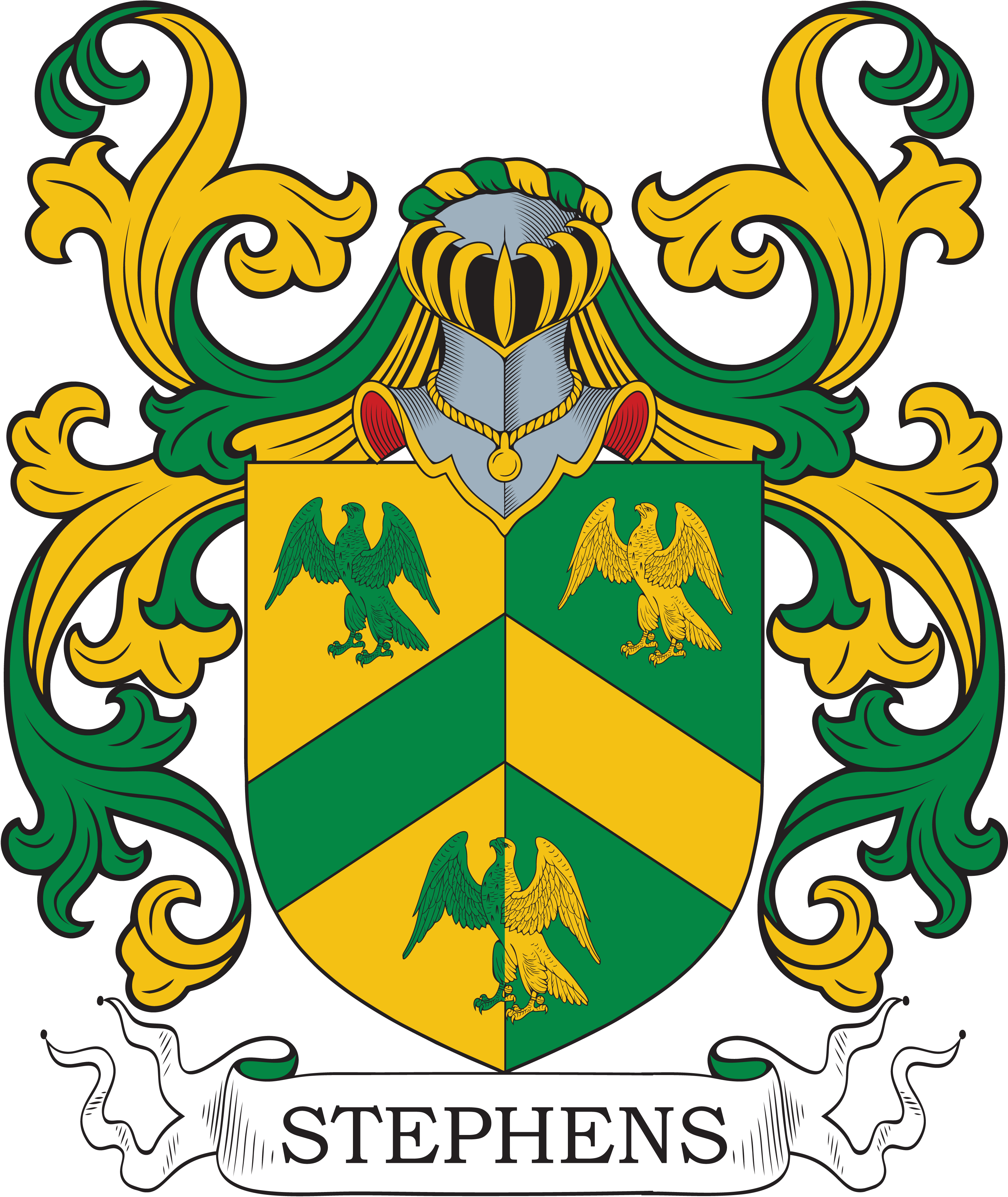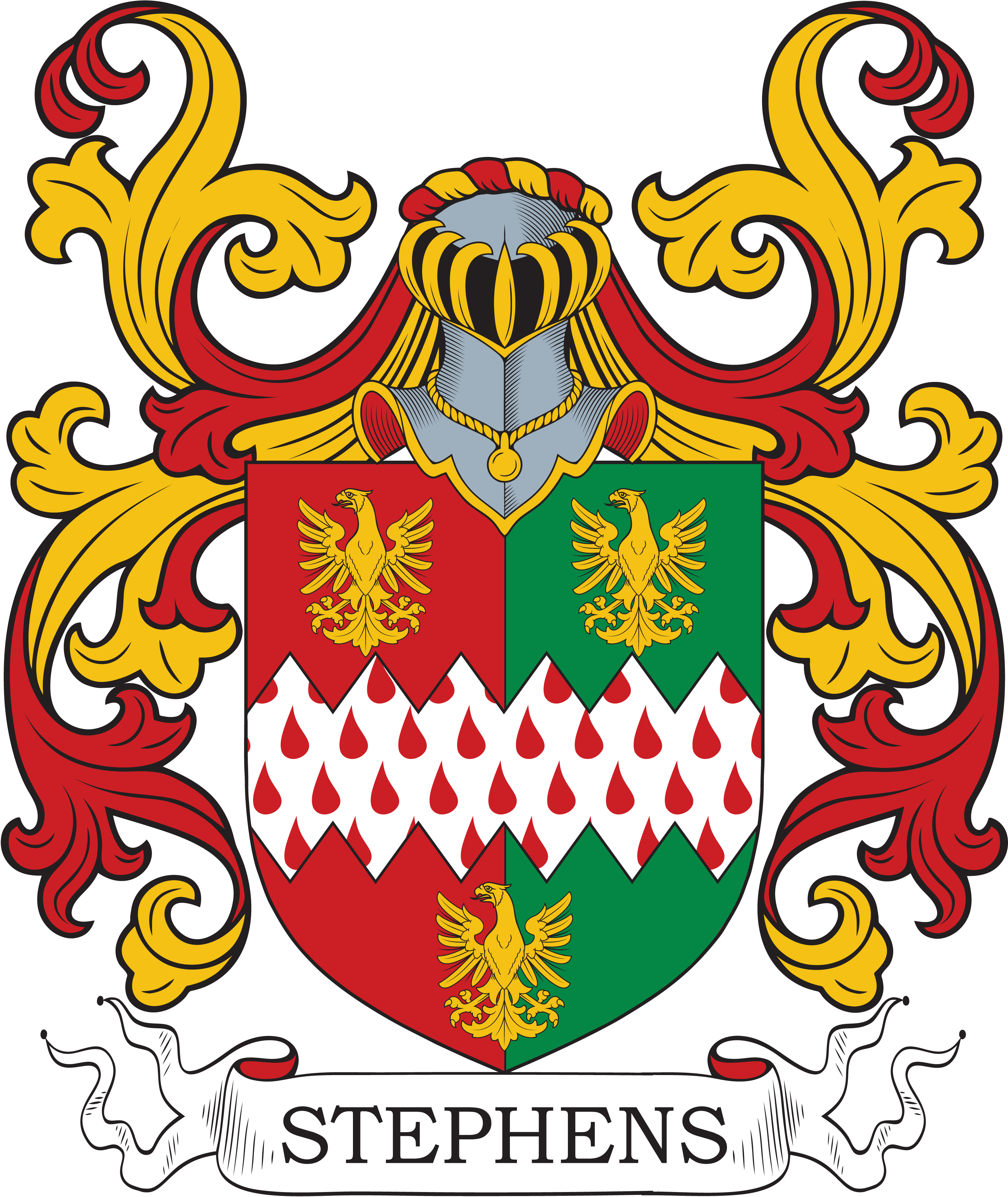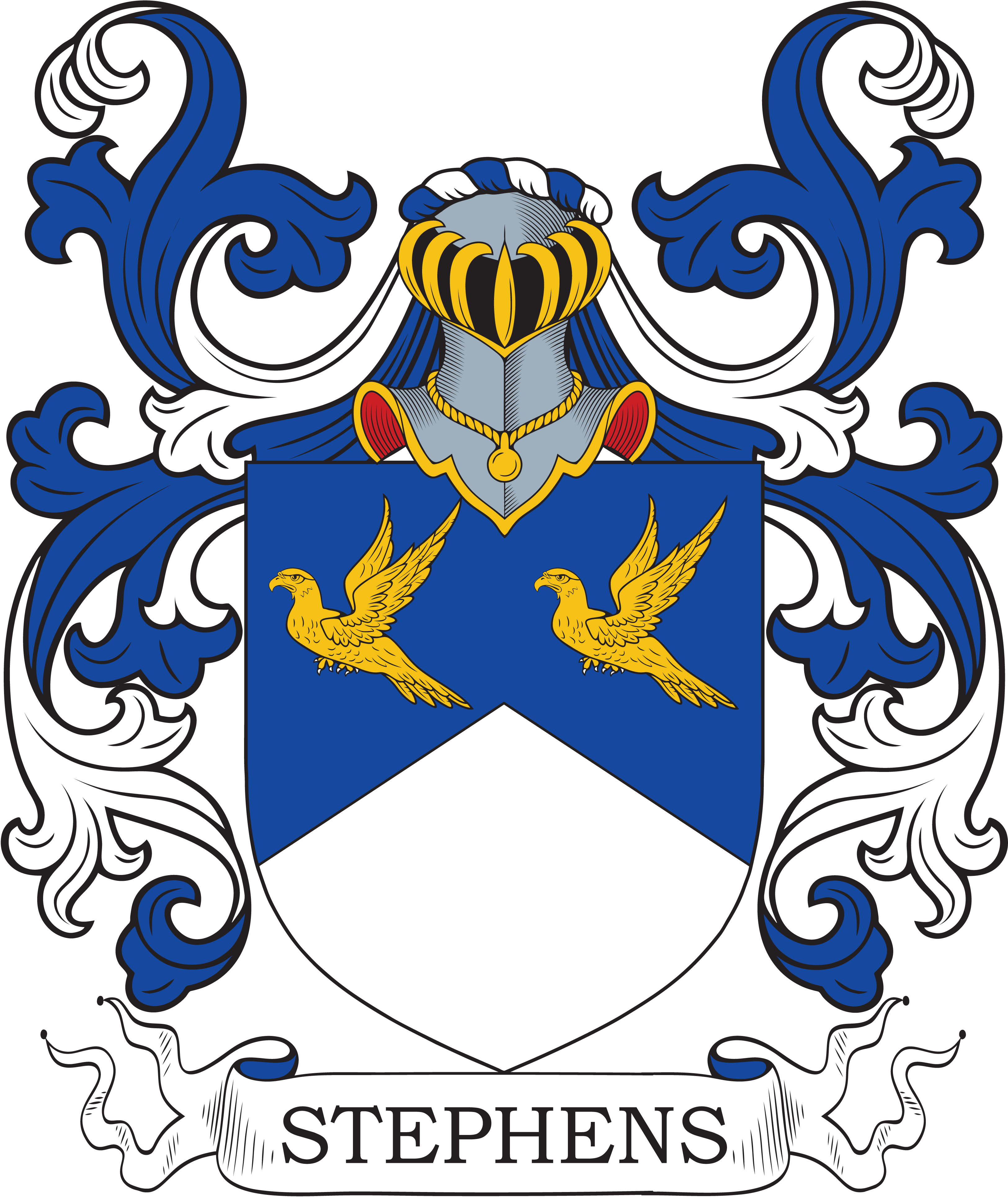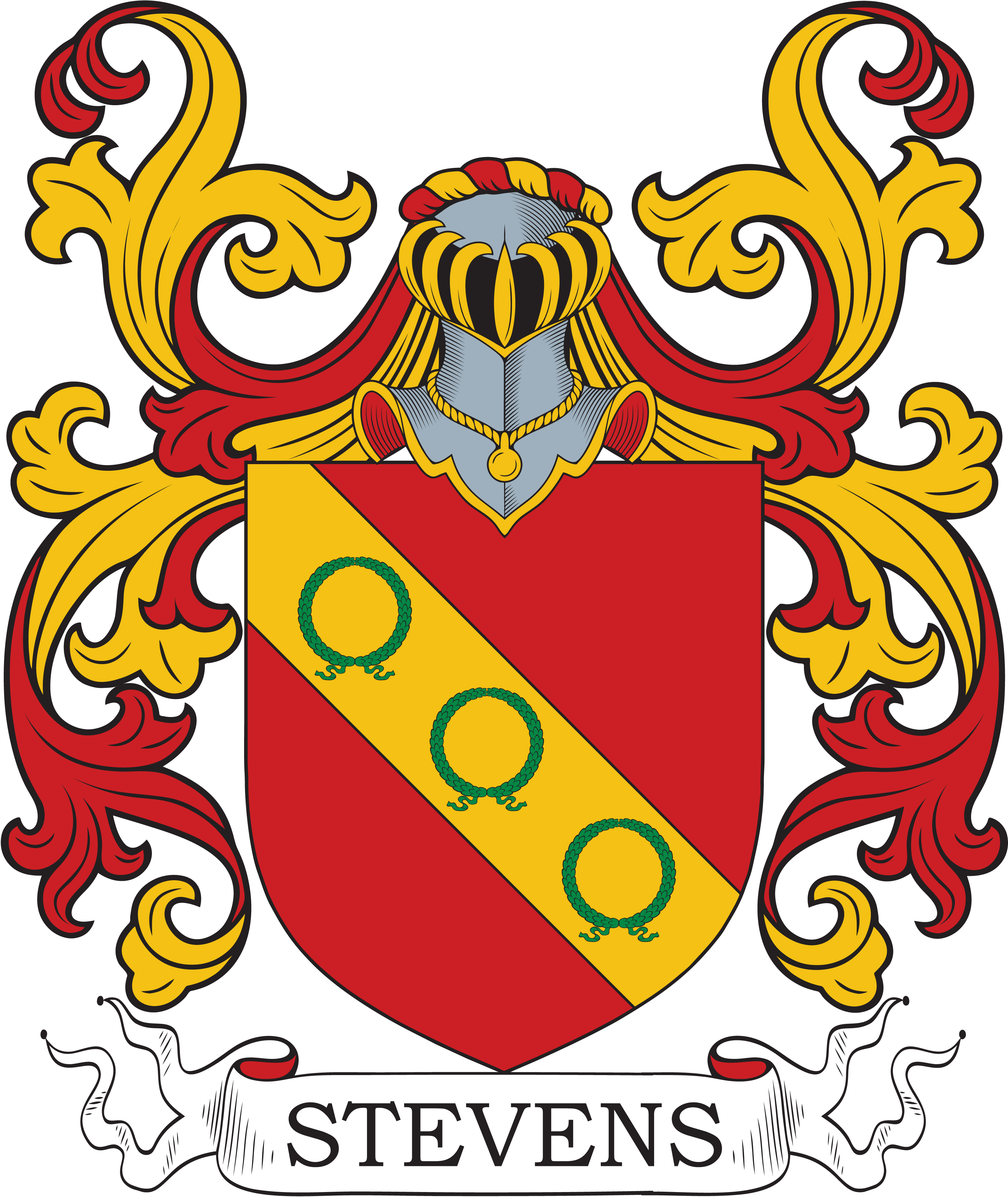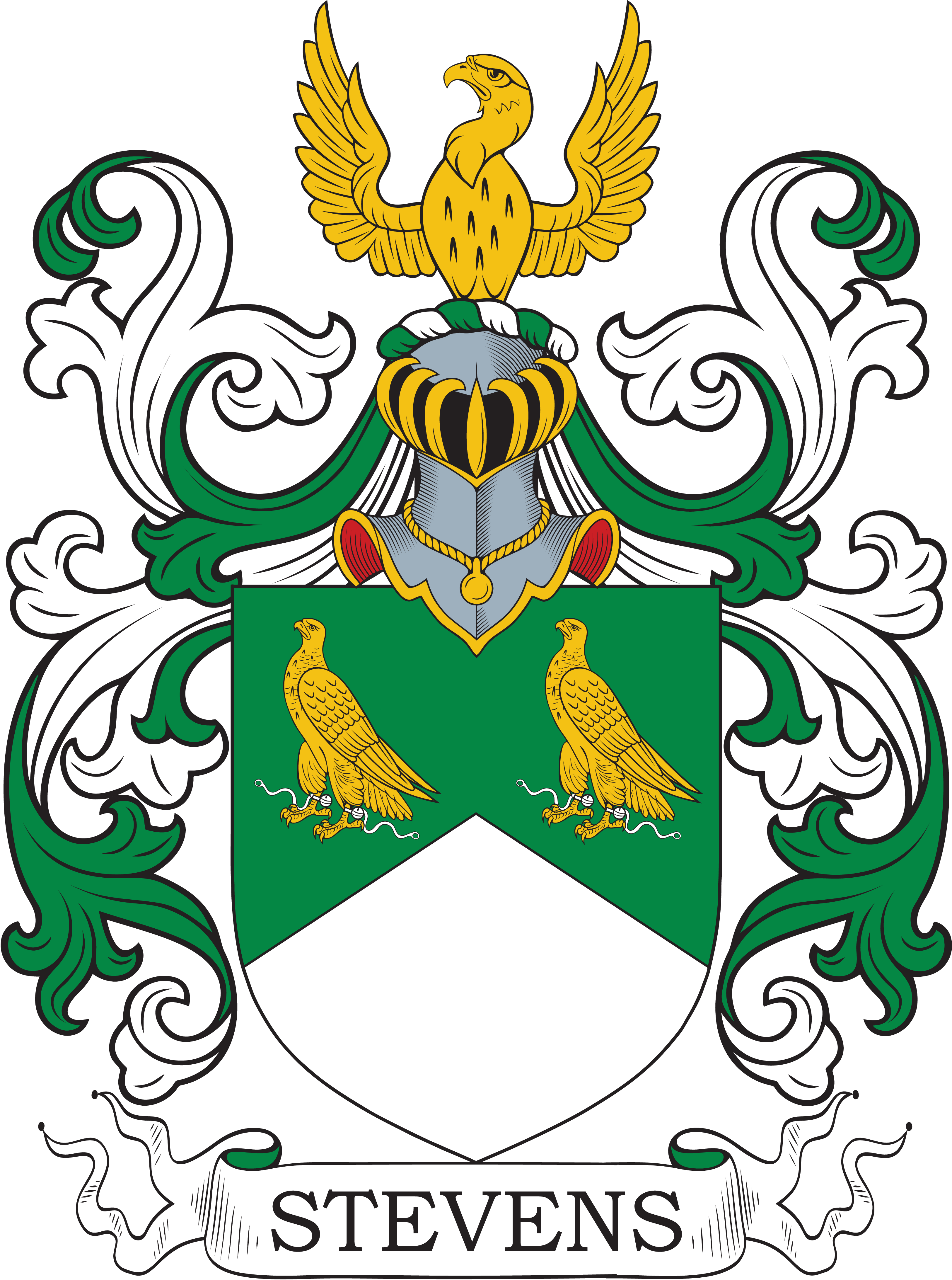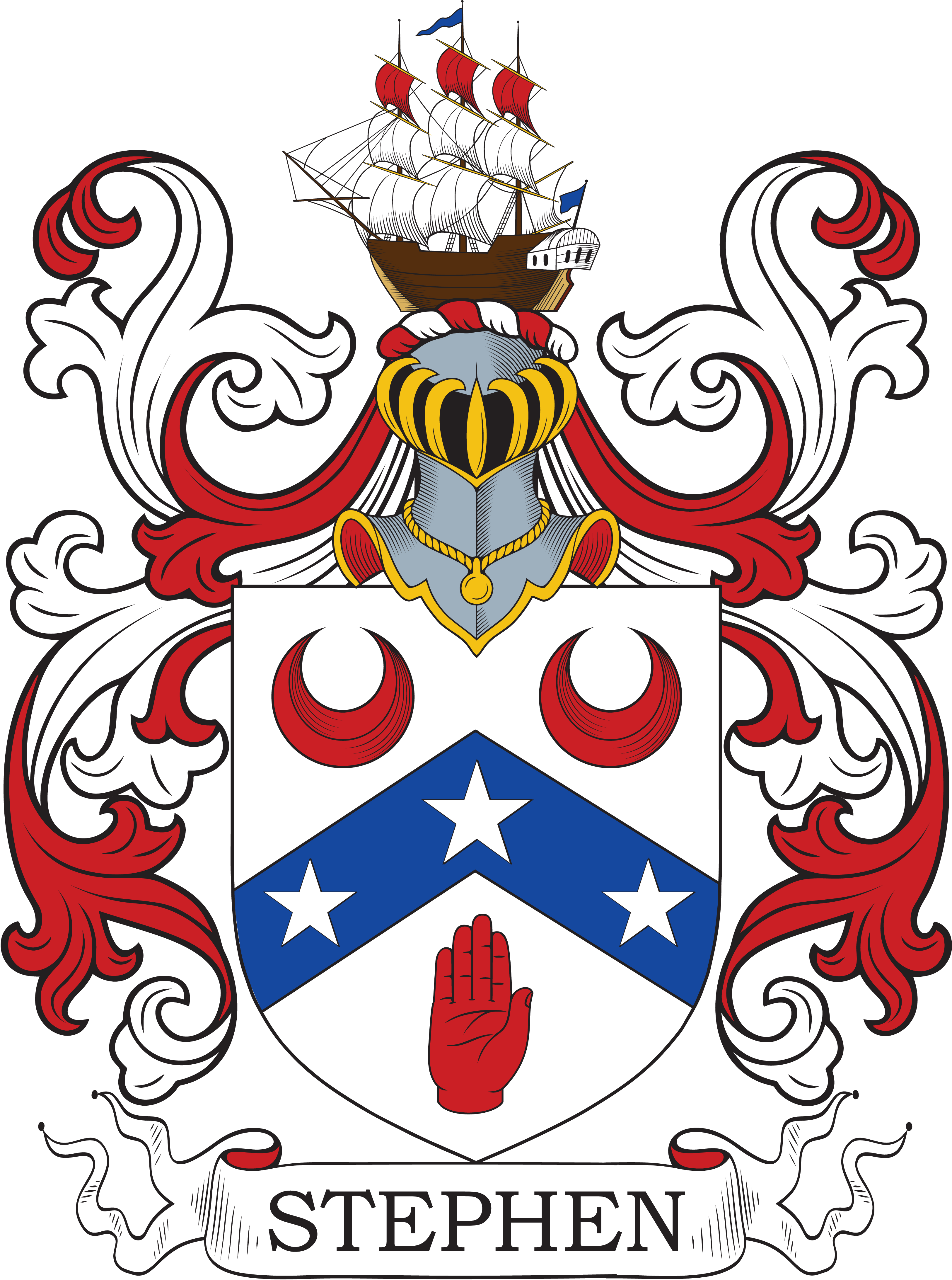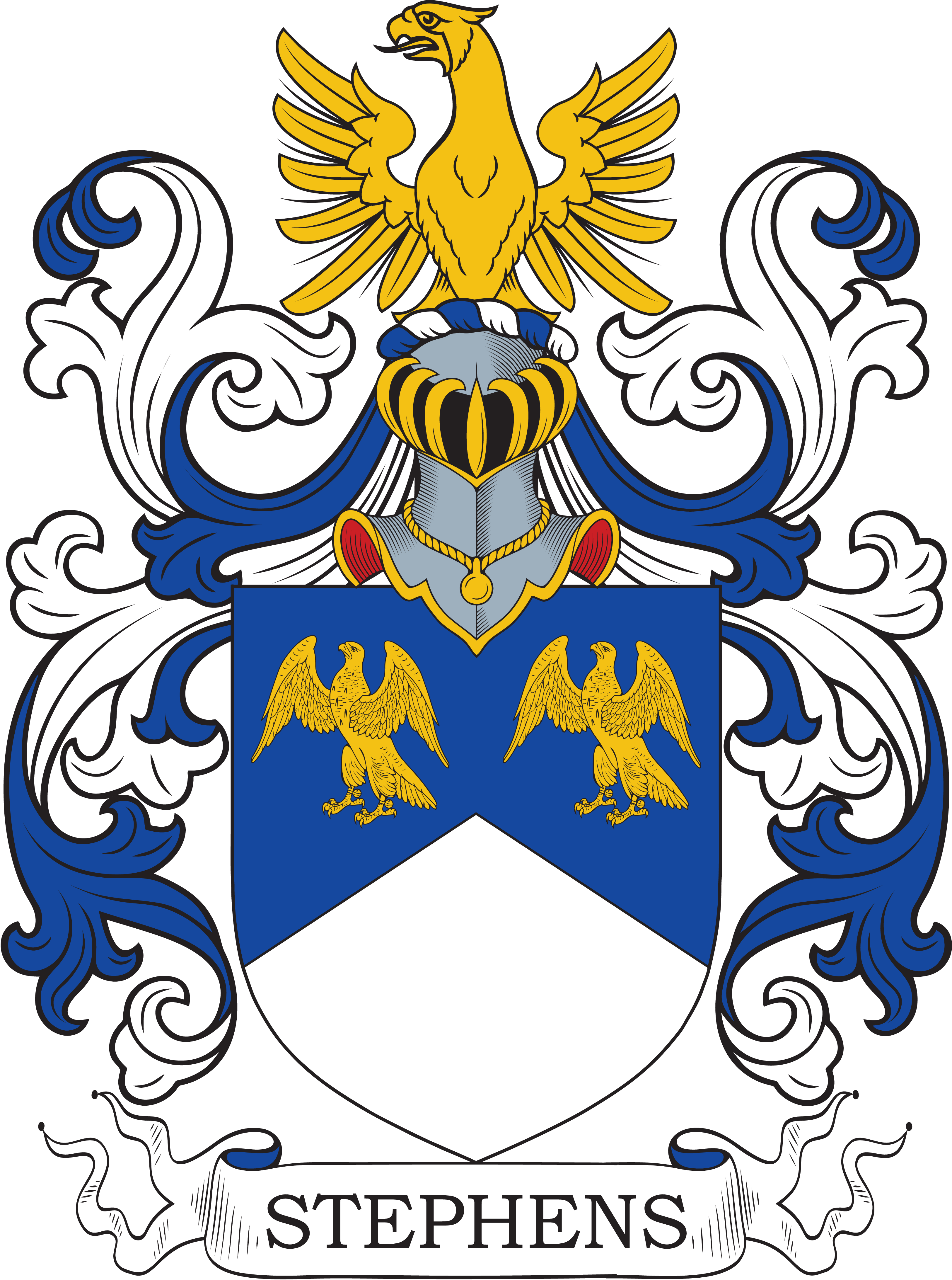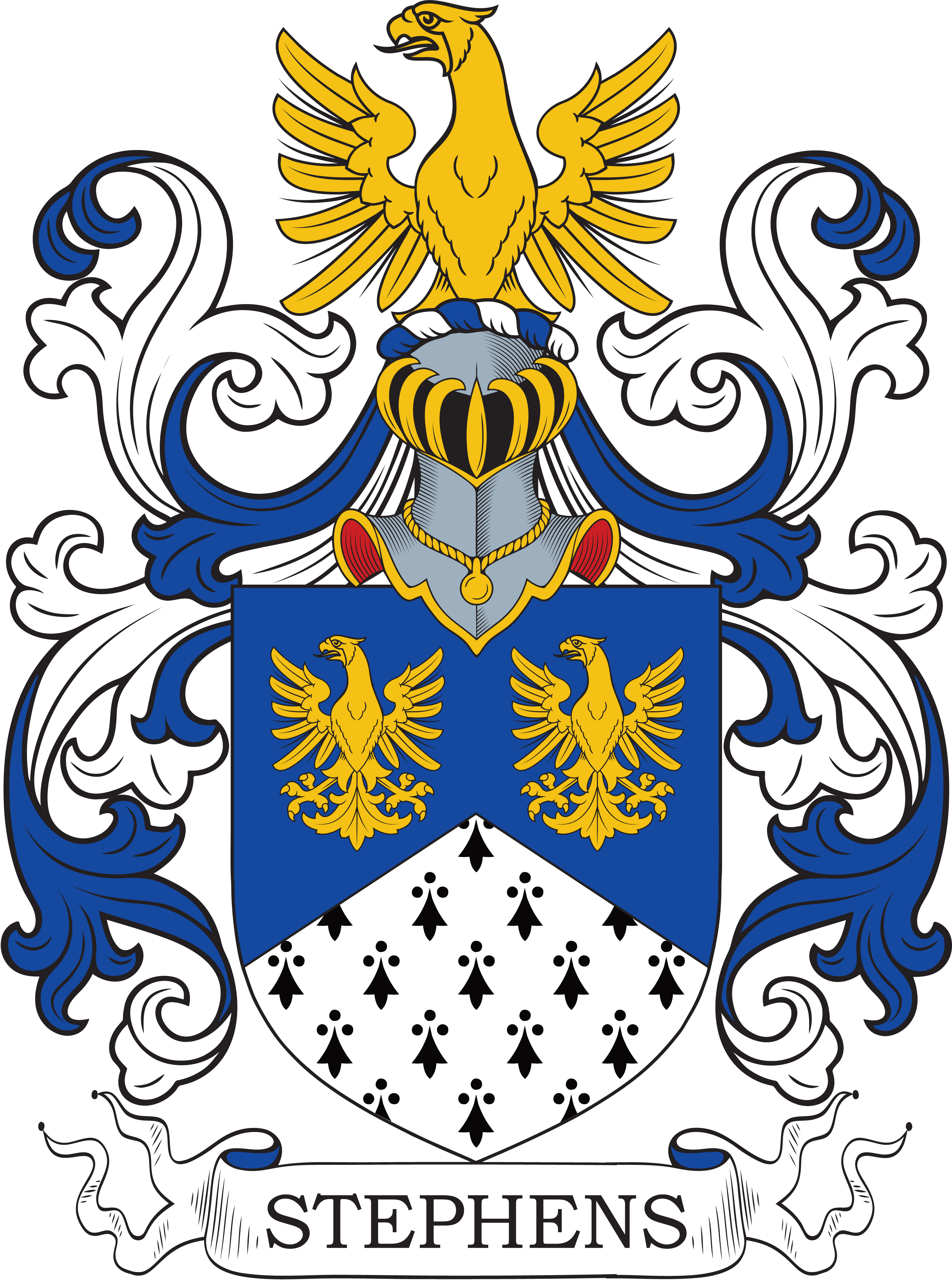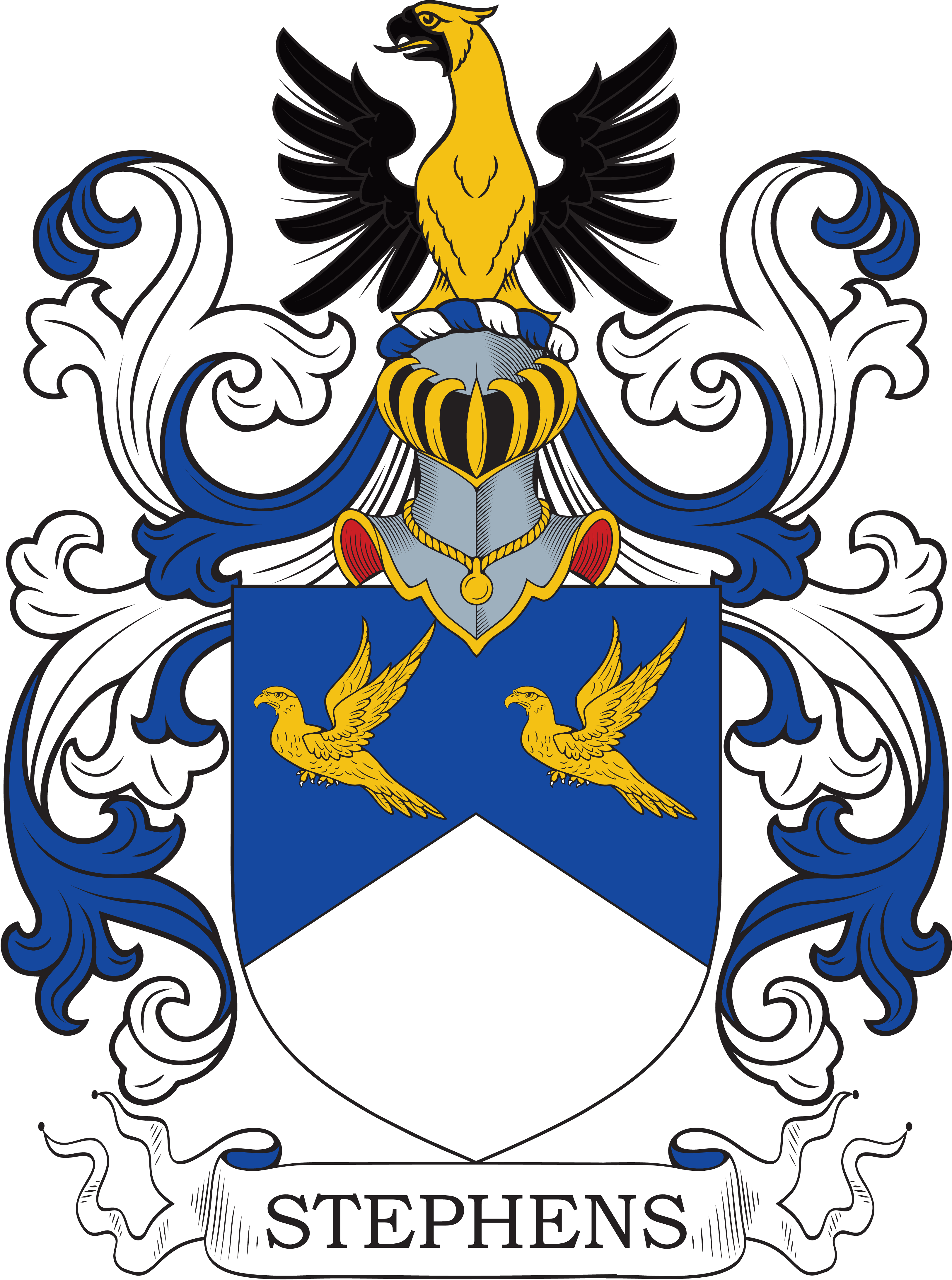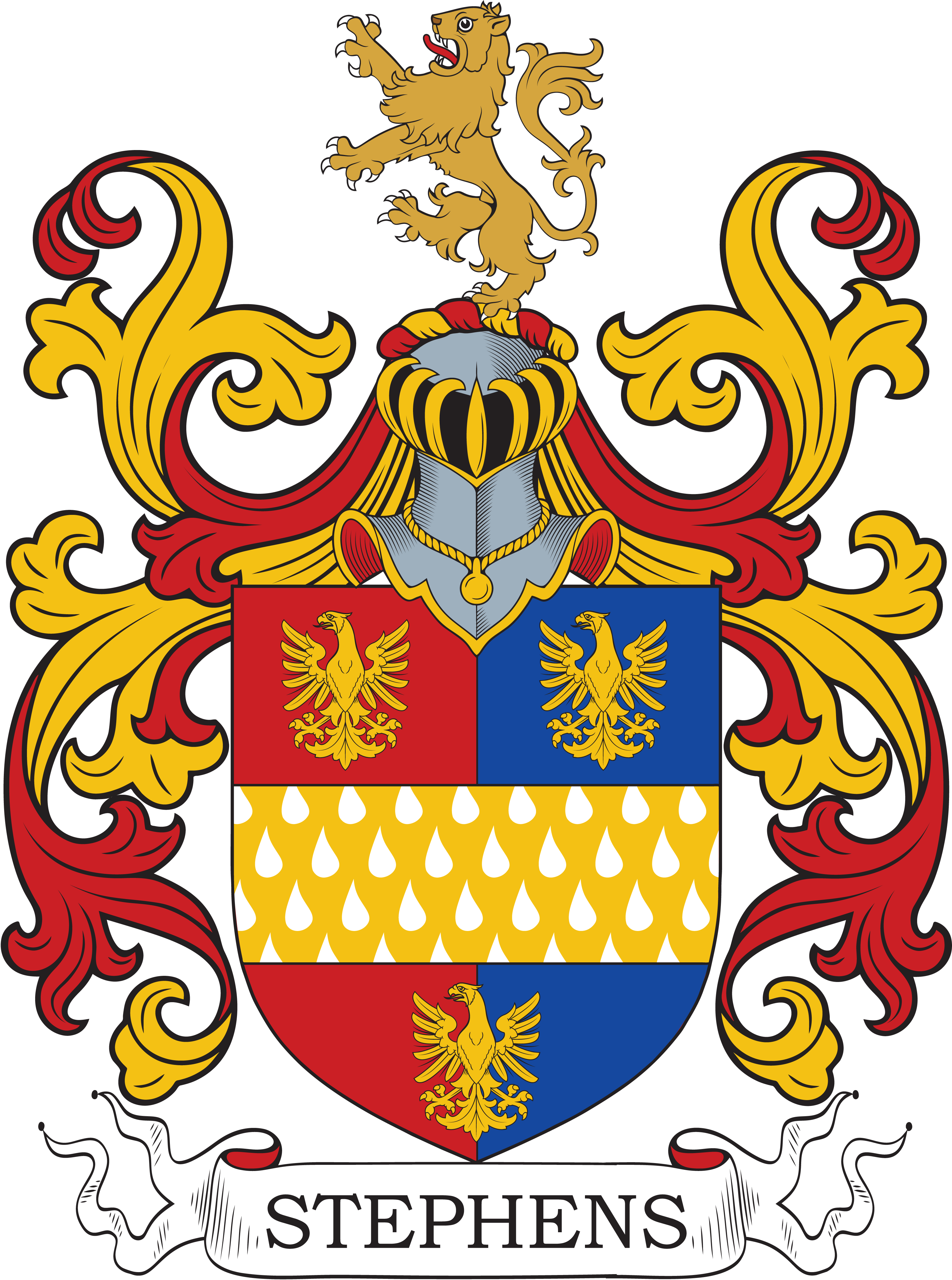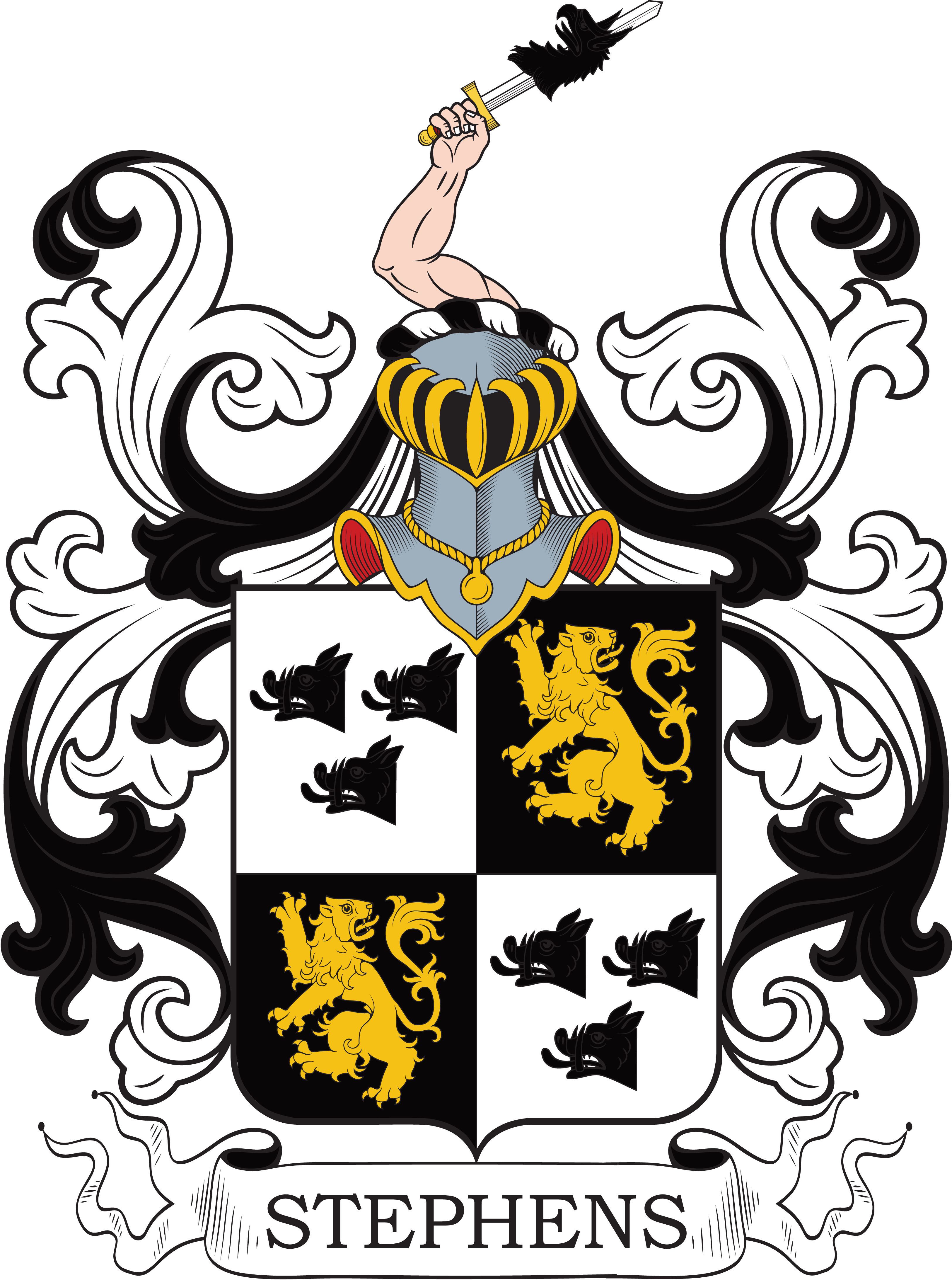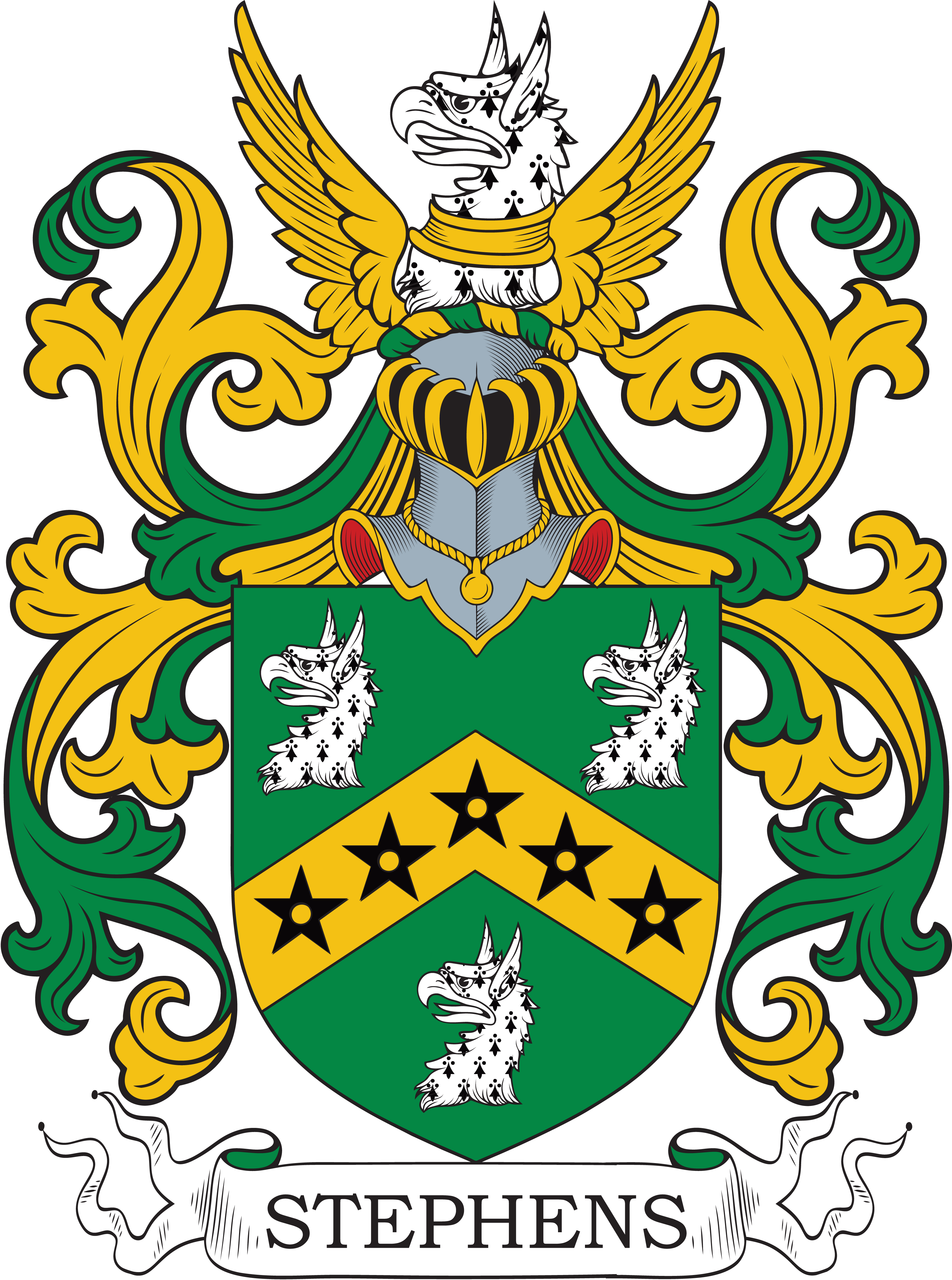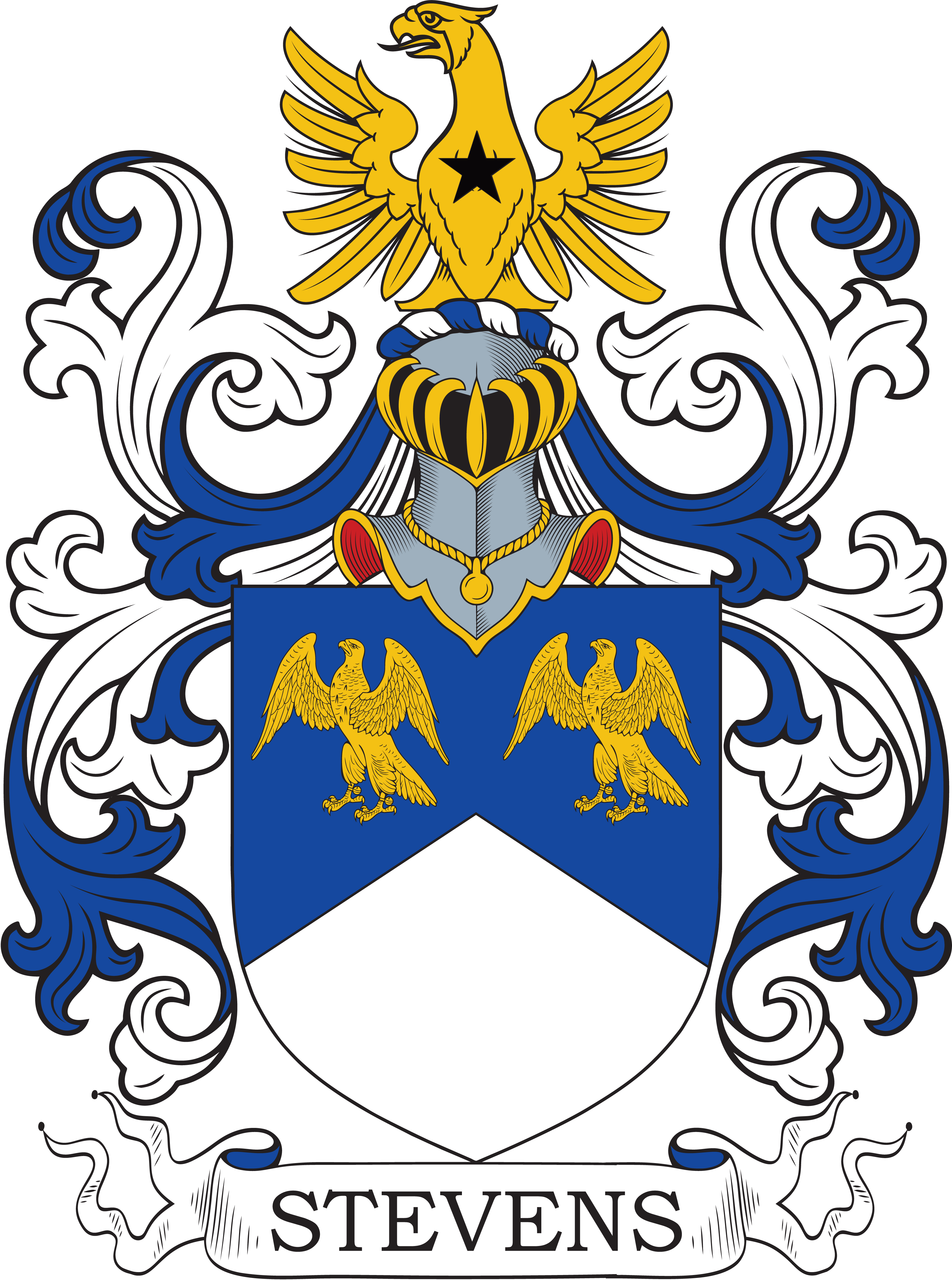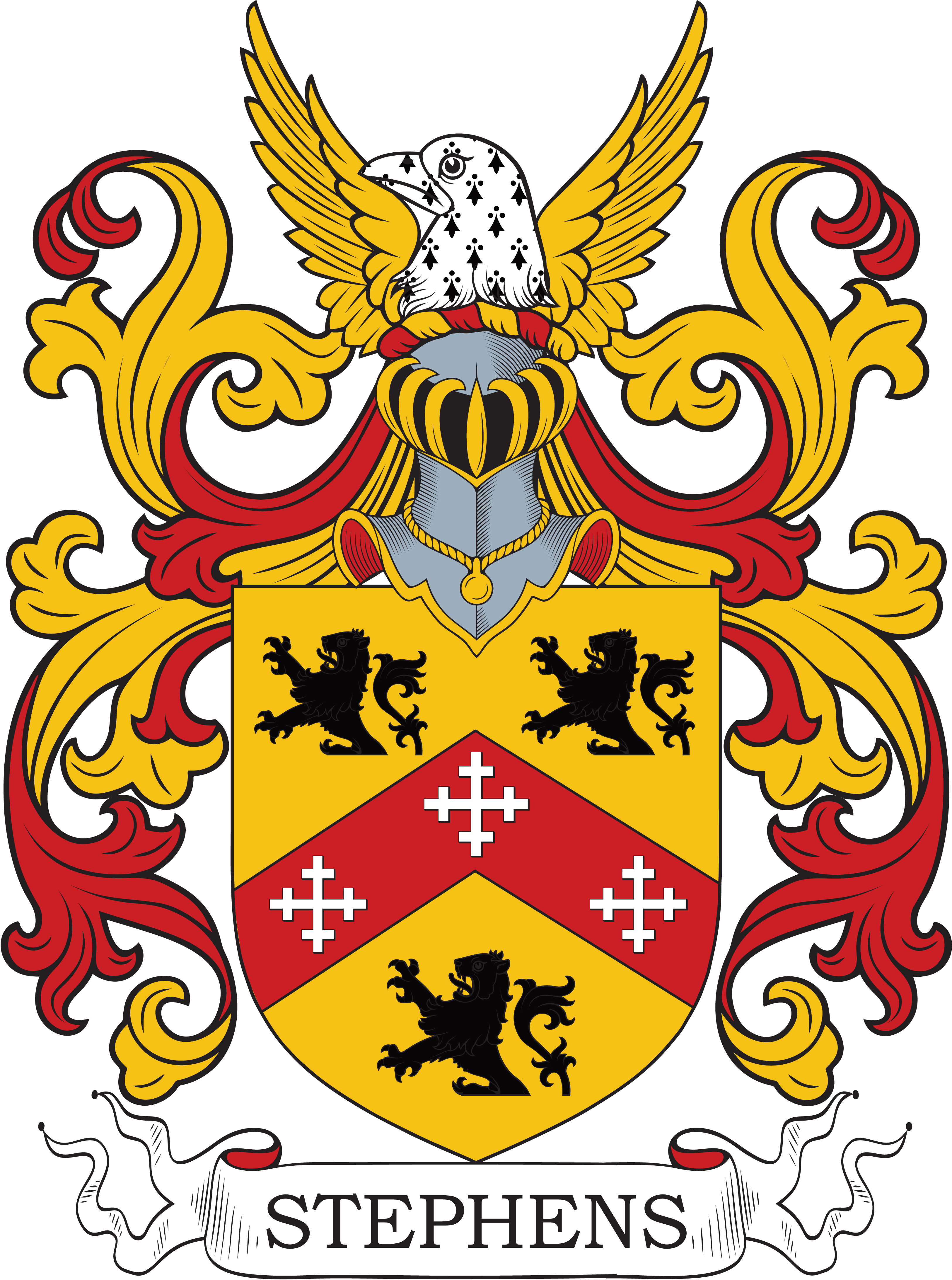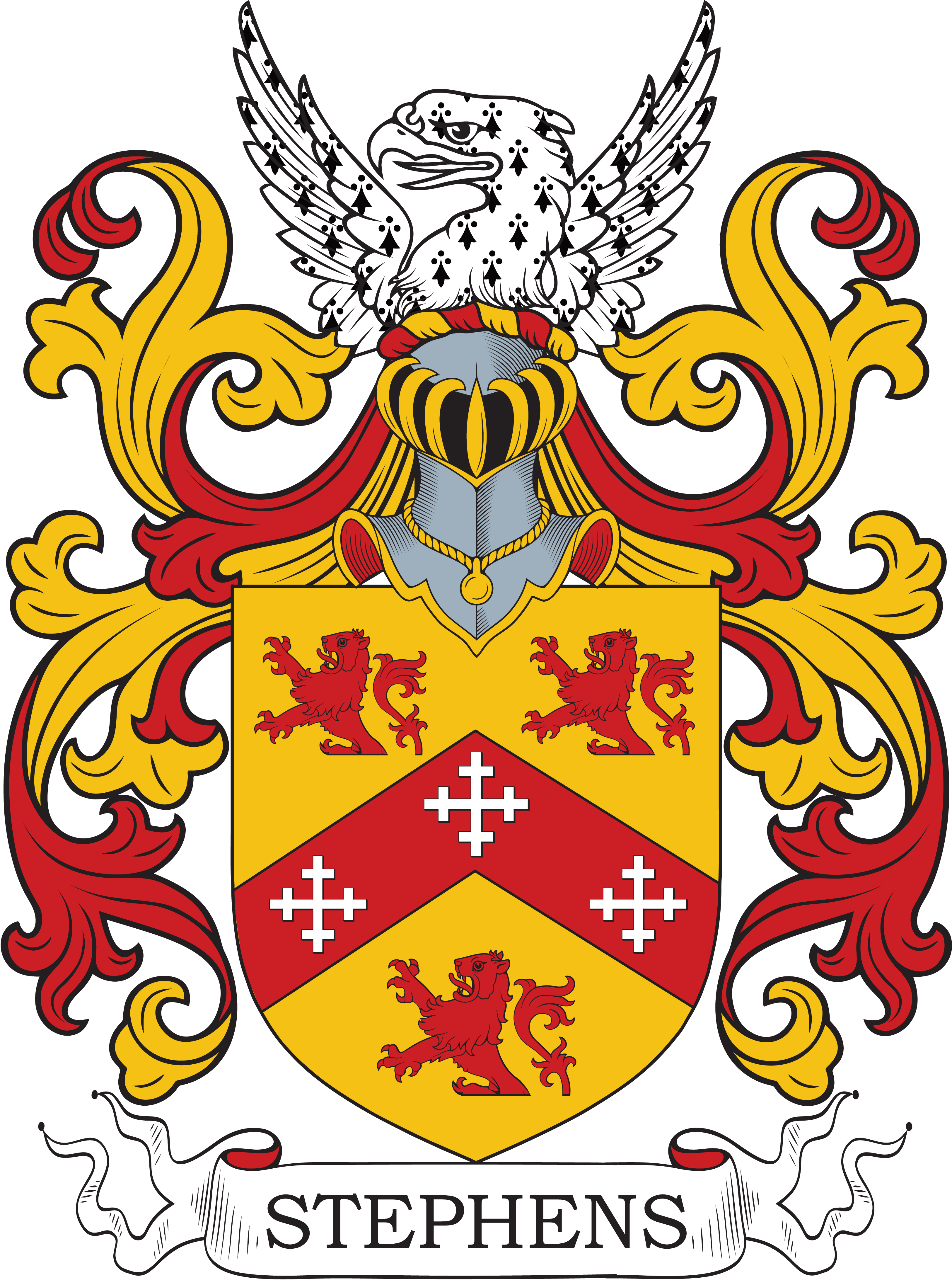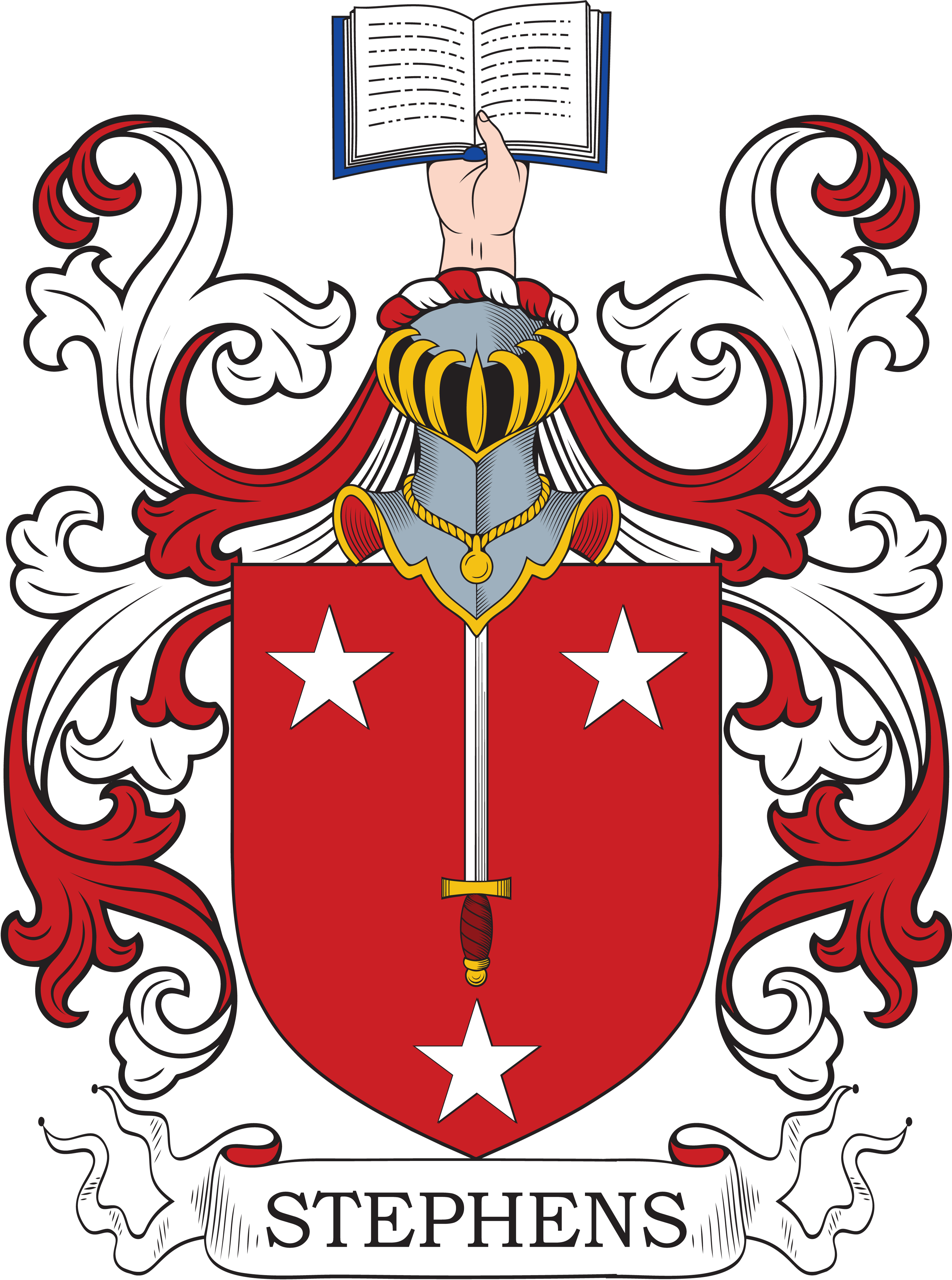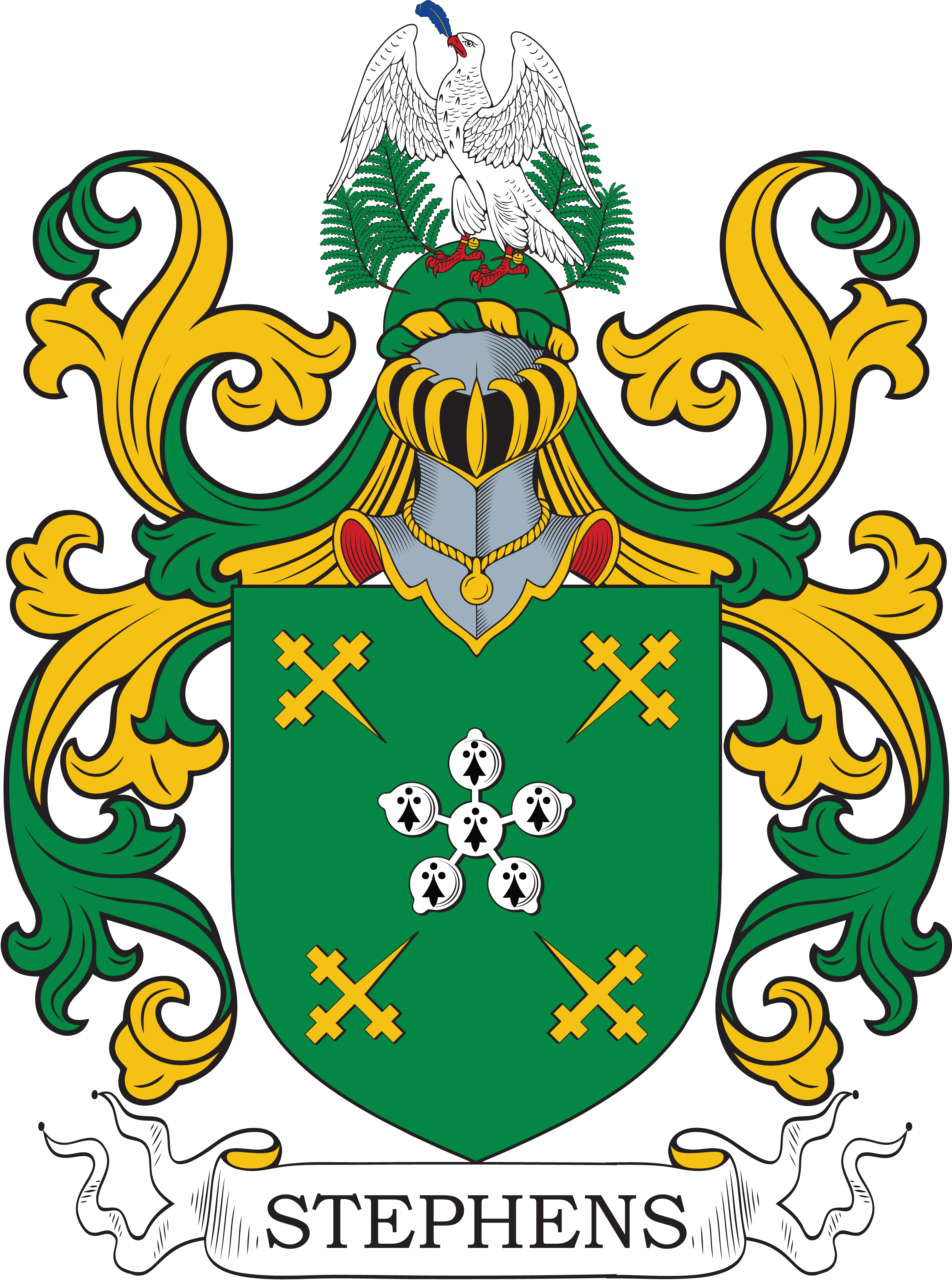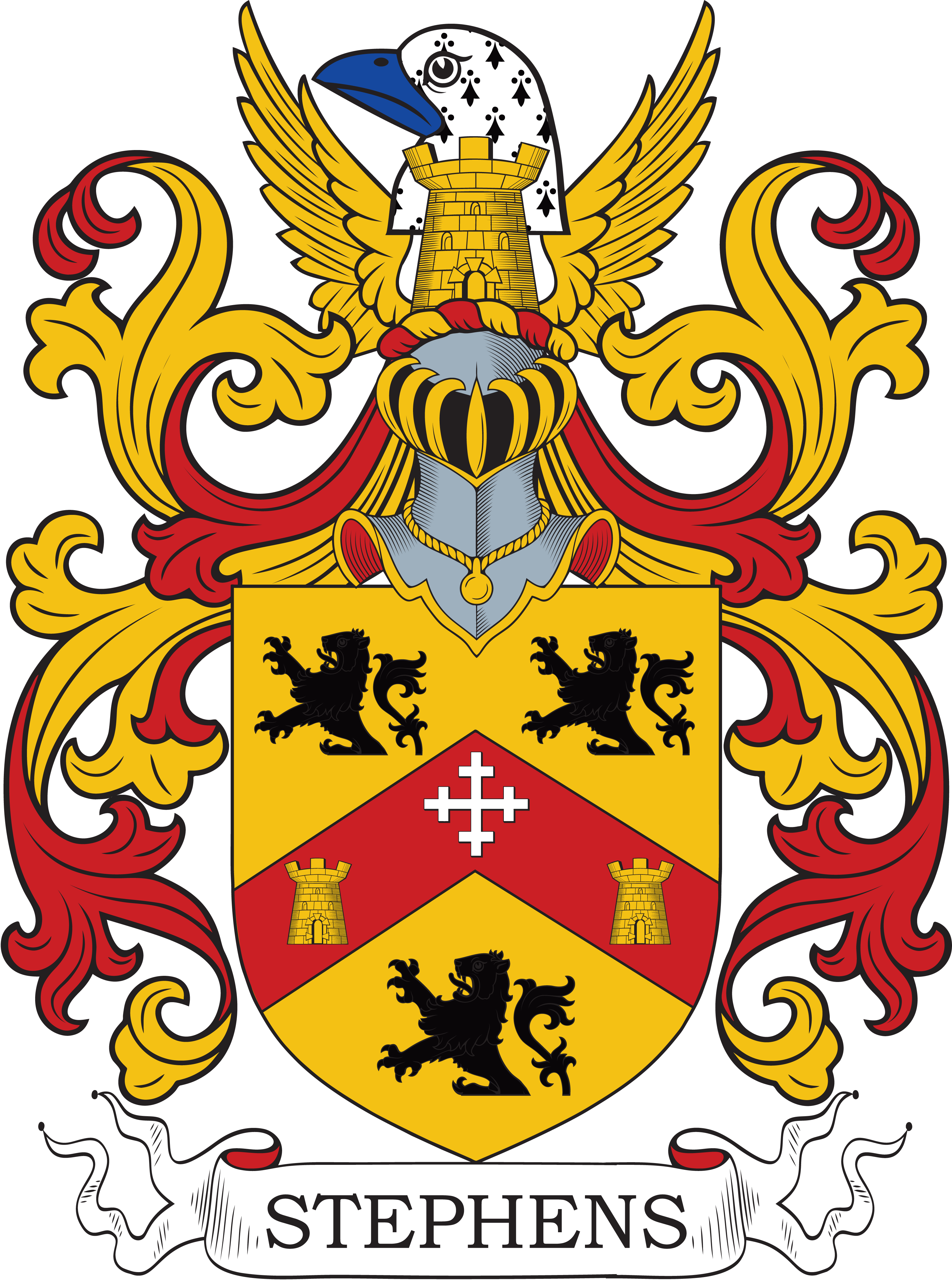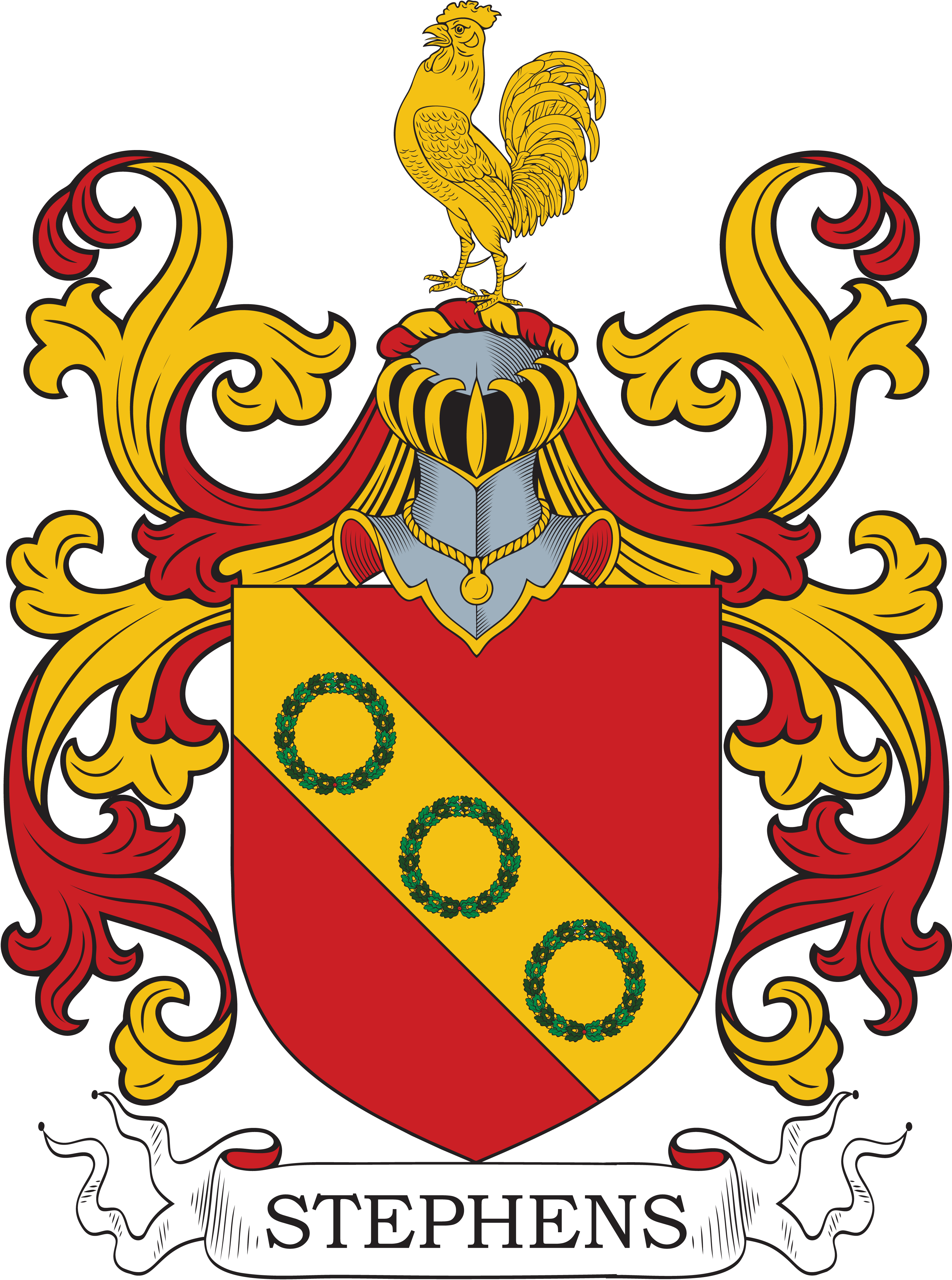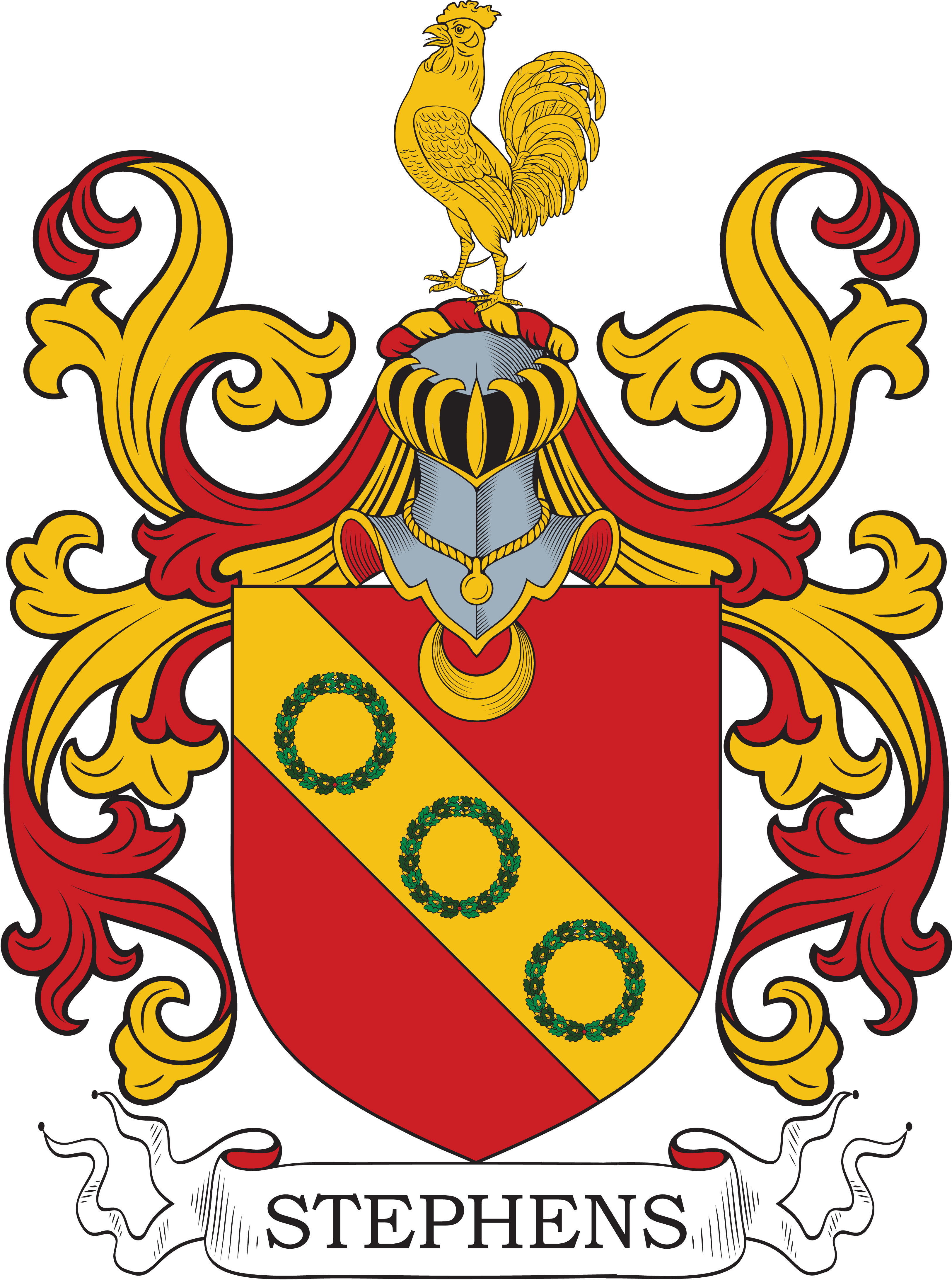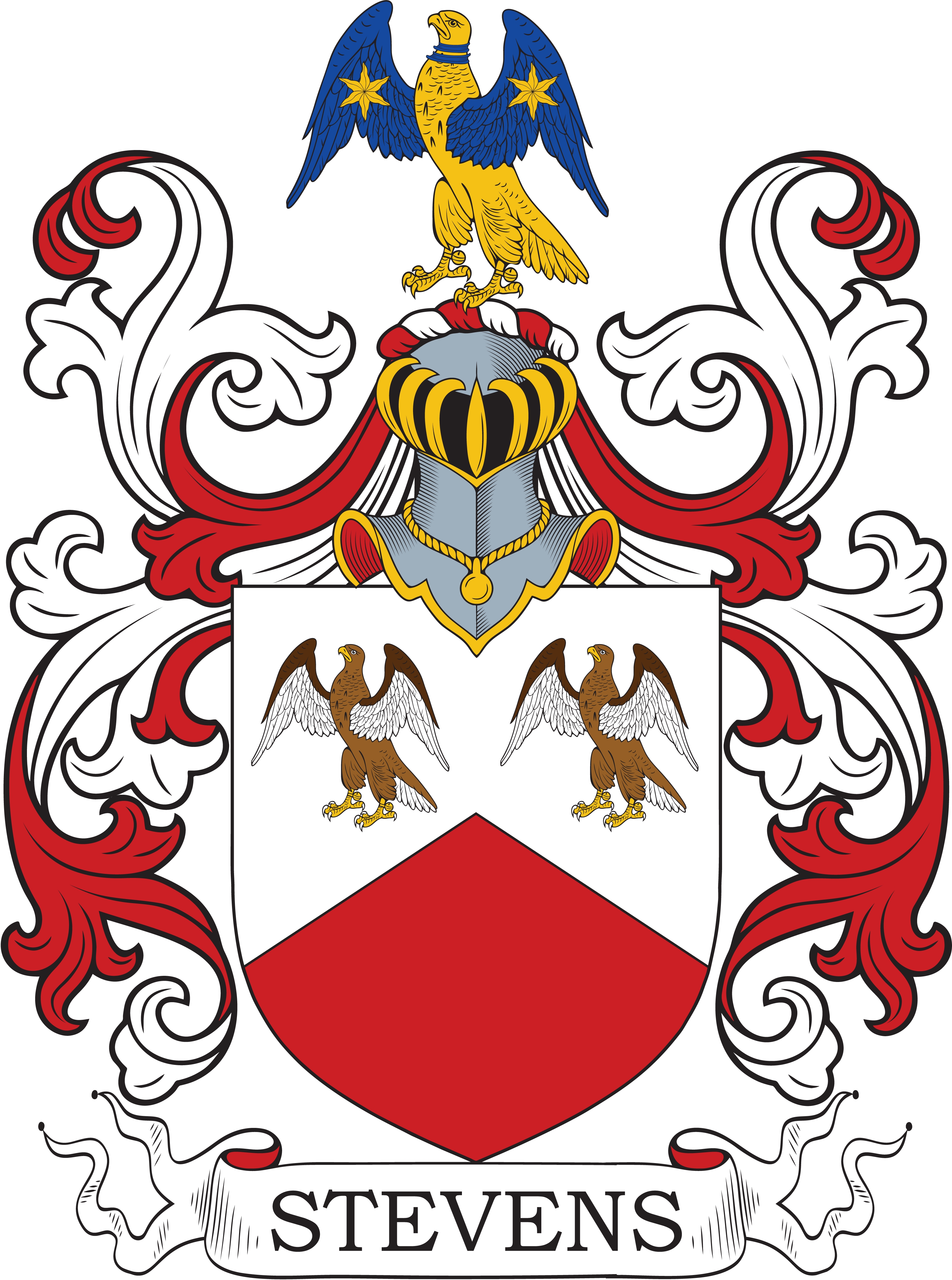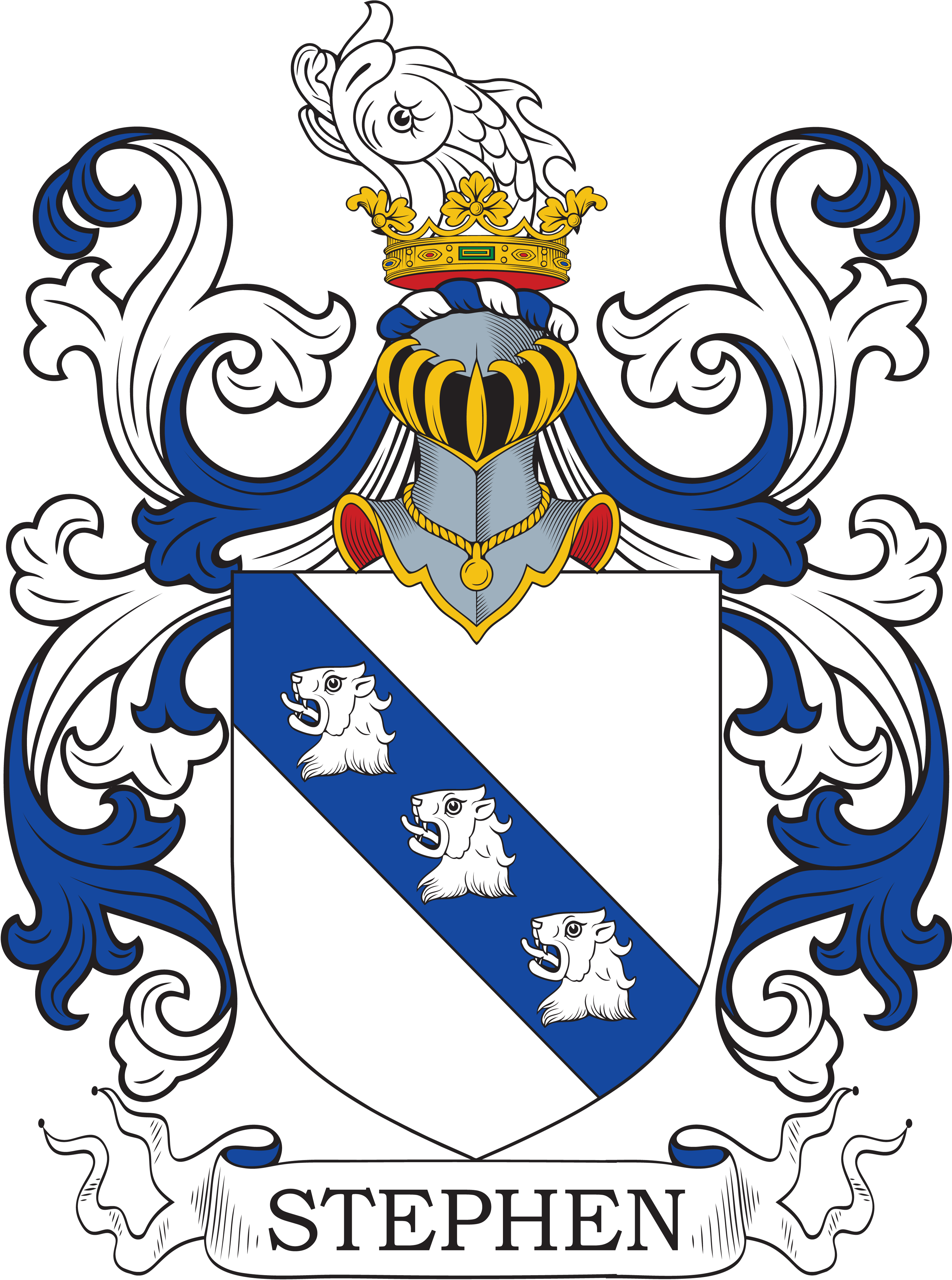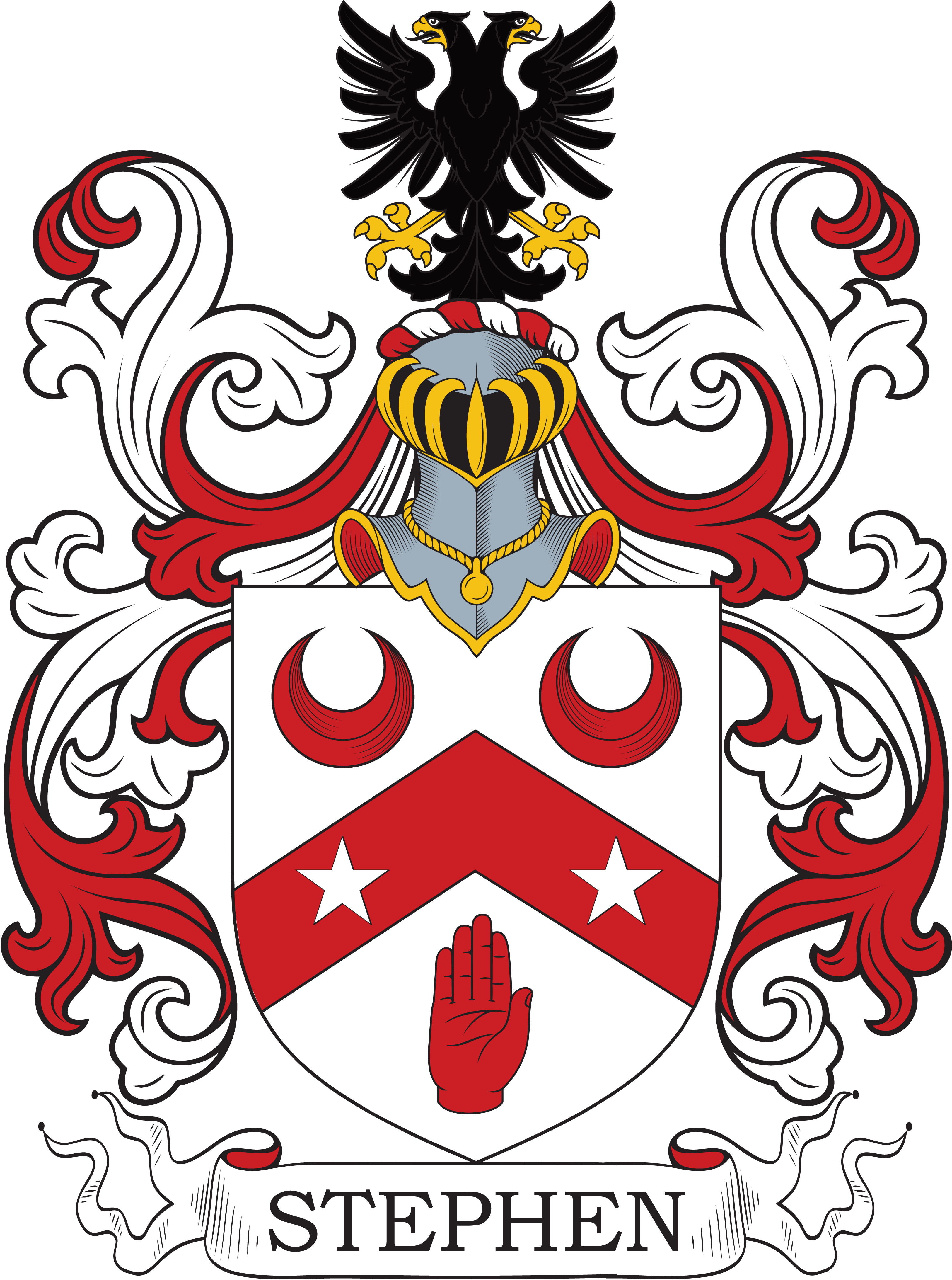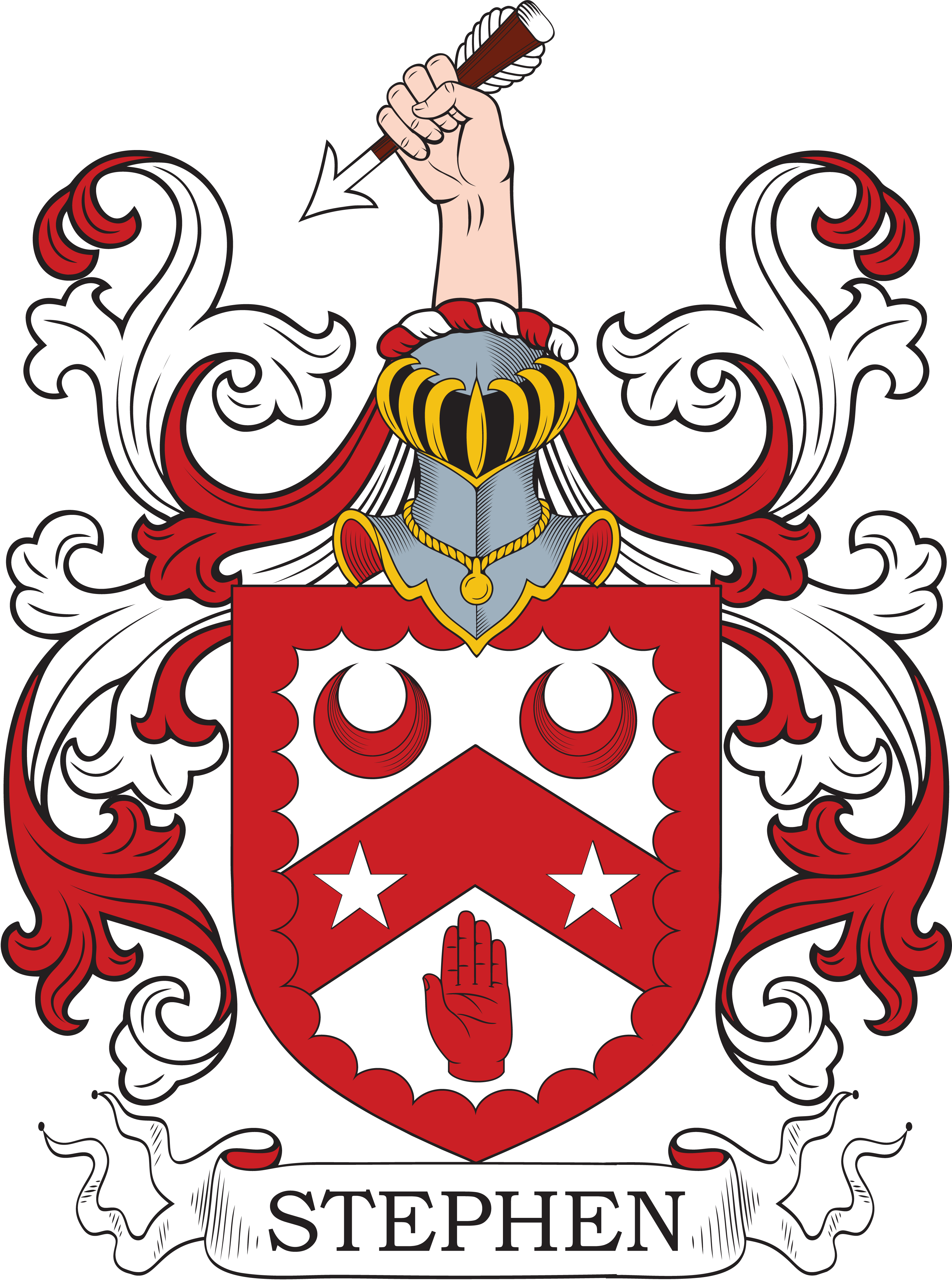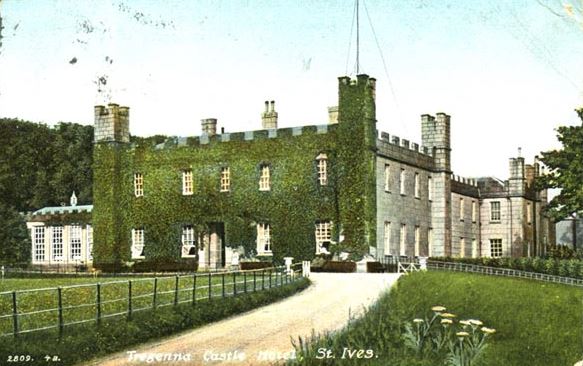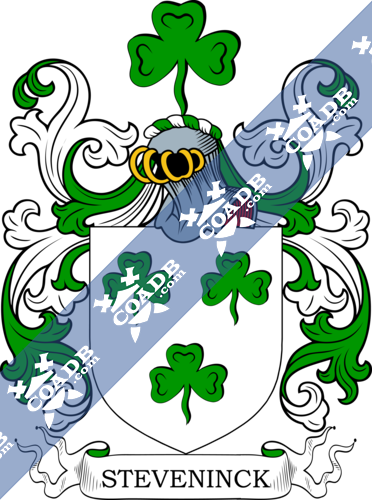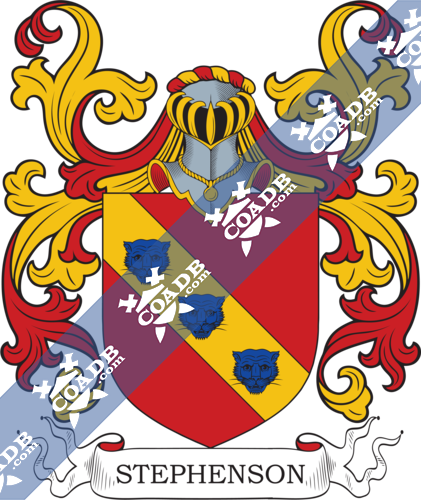Stevens Family Crest, Coat of Arms and Name History

Stevens Coat of Arms Gallery
Don’t know which Coat of Arms is yours?
We can do a genealogical research. Find out the exact history of your family!
Learn MoreSurname Name Meaning, Origin, and Etymology
The surname Stevens, Stephen, or Stephens is a baptismal surname meaning “the son of Stephen”, which is an ancient personal (first) name meaning crown, wreath, or garland, and literally translates as “that which surrounds or enconmpasses”.The given name is derived from the Greek Stephanos. In ancient Greece, a wreath was often given to the winner of a contest. In his book A Dictionary of English and Welsh Surnames by Charles Wareing Bardsley, states the following in regards to this name: “It was enormously popular in the hereditary surname period, and, as a consequence, has endless representatives of nick, and pet forms in the directories of to-day”. The name was undoubtedly popularized throught Britain, Europe, and Christendom by King Stephen I of England (1092-1154 AD), also known as Stephen of Blois (a city in central France), who was the grandson of William the Conqueror, the leader of the Norman Invasion of England in 1066 AD. The name was also popularized by an early Christian Saint, St. Stephen or Stephan (died in 36 AD), who was mentioned in the Acts of the Apostles in the Bible and was martyred. Ten Popes, as well as Kinds of Serbia and Poland, bore this first name. One author asserts the name was introduced in Britain as Fitz-Stephen
Spelling Variations
Common spelling variants or names with similar etymologies include Stevens, Stephen, Stephens, Stevenson, Stephenson, Steven, Stiven, Stimpson, Stephani,and Stephings. Foreign equivalents include Steffens and Steffin (Danish) and Stieven (Dutch).
Popularity & Geographic Distribution
The last name ranks Stevens ranks 122nd in popularity in terms in the United Status as of the 2000 Census. The name ranks particularly high in the following four states: Maine, New Hampshire, Vermont, and Montana. The name is also common in England where it ranks 93 in popularity. It ranks highest in the following counties: Buckinghamshire, Sussex, Kent, Surrey, Wiltshire, Berkshire, Oxfordshire, and Bedfordshire. The name is common throughout the English speaking world: Scotland (386th), Wales (116th), Ireland (1,212nd), Canada (199th), New Zealand (94th), Australia (86th), and South Africa (292nd).
The last name ranks Stephens ranks 181st in popularity in terms in the United Status as of the 2000 Census. The name ranks particularly high in the following four states: Georgia, Alabama, Kentucky, and Oklahoma. The name is also common in England where it ranks 269th in popularity. It ranks highest in the following four counties: Cornwall, Gloucestershire, Herefordshire, and Devon. The name is common throughout the English speaking world: Scotland (895th), Wales (76th), Ireland (820th), Canada (656th), New Zealand (201st), Australia (178th), and South Africa (1,033rd).
The 1890 book Homes of Family Names by H.B. Guppy states “Mostly confined south of a line drawn
west from the Wash, being represented in the counties north of that line by Stephenson and Stevenson. Its great home is in Cornwall, and there are secondary centres in Sussex, and in South Wales and in the adjoining English county of Hereford. The name is said to have been introduced after the Conquest. In Cornwall it is of very ancient date, as is evidenced by the family of Stephens of Tregeuna, -who, according to Lower, are the descendants of the Stephyns of St. Ives in the, reign of Edward IV., their name being written then in the singular”.
Early Bearers of the Surname
The name was first recorded as a personal name in England as Stefanus (latin version) in the Domesday Book of 1086 AD, which was a survey of Wales and England ordered by William the Conqueror. The first known bearer of this last name was Alice Stephens (or Stevens) who was documented in the Hundred Rolls of Huntigdonshire in 1279 AD. The Hundred Rolls of 1273 AD, a census of Wales and England, known in Latin as Rotuli Hundredorum, lists three bearers of this surname: Gilbert filius (son of) Stephani in county Lincolnshire, Jordan filius Stephani in county Essex, and Richard Stephen in county Oxford. A one Richard Stephenes was recorded in county Somerset in Kirby’s Quest during the reign of King Edward III of England (1327-1377). An early baptism involving this last name was Dorothy Stephens (daughter of William) at St. James Clerkenwell in 1585 AD. An early marriage involving this surname was James Stephen to Flora Young at St. George’s Hanover Square in 1739 AD in London.
History, Genealogy, and Ancestry
The famous genealogist Bernard Burke’s book The Landed Gentry discusses five branches of this family: Stephens of Eastington, Stephens of Tregenna, Stephens of Llanno, Stevens of Bradfield, and Stevens of Winscott.
The first begins with a mention of Richard Stephens, Esquire of Eastington in Bournemouth who was a Justice of the Peace for Hants and a Deputy Lieutenant for county Leicester. He was born in 1824 and in 1850, he married Henrietta Maria, daughter of Lieutenant General Sir Henry Pottinger, and had four children with her: Henry Pottinger Lygon (1851), Edward Richard Boyle (1852, Lieutenant in the Royal Navy), Percy Somers Tyrington (1860), and Emily Henrietta. This family was seated through the late seventeenth century in county Gloucester where it had possessed land for two hundred years. It lost many of its possessions during the English Civil War. The family split up and one branch settled in Essex and the other of Leicester, having become likely extincty. Henry Stephens was a land owner in Gloucestershire, the first member of this branch, and he lived at Forcester and was buried at St. Peter, with a will dated 1552. He married the daughter of Edward Lugg and had several children with her, including his air Edward. Edward purchased the manor of Eastington from Lord Stafford in 1573. He married Jane, daughter of R. Folwer, and they had three sons and three daughters. His third son was John Stephens of Over-Lypliate, a parish of Stroud. John was the Attorney-General to Charles I, Prince of Wales. John married Elizabeth, the daughter and co-heir of John Stone, and had several daughters and three sons with her: Edward, John, and Nathaniel. The third son Nathaniel Stephens succeeded his father. He was an Esquire of Horton and Cheriton. He married Elizabeth, daughter and heir of Robert Tyringham, and had two issue with her: Edward (Barrister at Law who married Mary Raynsford in 1682) and Tyringham. The Venerable Tyringham Stephens of The Castle, near the borough of Leicester; was Archdeacon of Leicester in 1635. His second wife was Millicent, daughter of William Inge, Esq. of Thorpe Constantine, county Stafford, and by her had issue: Tyringham (1672), Walter (1675), Thomas, and Nathaniel (1697, Rector of Alphamstowe). The third son was Thomas Stephens, who was born in 1679 and was an Officer in the army. He married Hannah, daughter of Francis Ward, and had numerous children with her: John, Thomas (1710, married Hannah Garrett), Elizabeth (1700), Hannah (1703, married J. Cape of London), Mary (1706, Lawrence Reade), and Anne. The eldest son John, Esq. of St. Martin’s, Leicester, was born in 1707 and married Elizabeth, daughter of John Barfoot, and had four issue with her: John, Thomas, William, and Richard. John was succeeded by his fourth son Richard. Richard was born in 1745 and he married Alice, daughter of Reverend John Lettice, and had two issue with her: John, Richard (born 1785, educated at Rugby, was Vicar of Belgrave-cum Birstall), Elizabeth (married Samuel Bankhart), Alice, Ann (married John Cadecott of Holbrook Grange), and Alice (married Reverend Henry Greene of Upton Snodsbury). His eldest son, John Stephens, Esq. of St. Martin’s, was born in May of 1775. He married Maria, daughter of Walter Ruding, and had issue with her: John Ruding, Richard Ruding, Elizabeth Ruding, Sarah Ruding, Agnes Sarah Ruding, Maria Ruding, and Katherine Ruding. He was succeeded by his eldest son, John Ruding Stephens Esq., who was born in 1803. In 1843, he married Harriet, daughter of Reverend Rogers Ruding, but died without issue. He was succeeded by his brother Reverend Richard Ruding Stephens born in 1807. Richard was educated at Winchester College and in 1857, married Elizabeth, daughter of William Croom. He died without successors, and was succeeded by his cousin, Richard Stephens. The family had the following heraldic blazon: Quarterly: 1st and 4th, Stephens, per chevron az. II arg. in chief two falcons volant or; 2nd, Lugg, Gules, on a ?? cottised arg. a bendlet wavy azure ; 3rd, Tyringham, azure saltire engrailed argent and a crescent or, for difference.
The second branch begins with a mention of John Augustus Stephens, Esq. of Tregenna Castle, Justice of the Peace for Cornwall. The family possessed estates in Cornwall for at least four centuries. During the reign of King Edward IV (1461-1470), a one John Stephyn settled in the borough of St. Ives, worked as a merchant, and acquired sizeable possessions. Later, a one John Stephens of the same local was fined for refusing to receive knighthood at the coronation of King Charles I (1625-1649). Another John Stephens, purchased the ancient manor of Killigrew, county Cornwall and descended from the John Stephyn mentioned previously. He married a woman named Mary, daughter of Samuel Phillips, and had a son with her named Samuel Stephens. Samuel was an Esquire and a Member of Parliament for St. Ives. In 1763, he married Anne, daughter of Richard Seaborne of Hereford, and had issue with her named John, Samuel, and Augustus. He died in 1794 and was succeeded by his son Samuel. This Samuel was of Tregenna Castle, was a Member of Parliament, Justice of Peace, Deputy Lieutenant, and High Sheriff in 1805. In 1796, he married Betty, child and heir of Captain Samuel Wallis, of Tremaine, and had issue with her: Samuel Wallis, John Augustus, Francis Hearle (Major 1st Royal Dragoons), Rev. Ferdinand Thomas, and Sarah Maria (married Charles William Davey). He died in 1834 and was succeeded by his eldest son, Henry Lewis Stephens, who died in 1867 and was succeeded by his brother. The Stephens Family Crest, granted by Henry Stephens, direct ancestor of the family, is blazoned as follows: Per pale gules and vert a fess indented argent guttee-de-sang between three eagles displayed or.
The third branch begins with a discussion of John Stephens, Esq. of Castle Vale, Llananno, in county Radnor. He was born in 1814 and was a Justice of the Peace (for Radnor and Montgomery) as well as Deputy Lieutenant (for Radnor). In 1844, he married Hannah Rogers, daughter of James Stephens. Burke traces the genealogy back to an old Radnorshire family, members of which served in the office of High Sheriff. The grandfather of the present owner was Evan Stephens of Cyrchell. In 1775, he married Anne, daughter of Edward Morgan of Aberbechan Hall, and died in 1833, having left four issue: Evan (1807), Edward Morgan (1809), John, Mary Anne (1834, married William Turner Hayward). The Stephens Coat of Arms had the following blazon in heraldry: Quarterly: 1st and 4th, argent three boars’ heads couped sable; 2nd and 3rd, sable, a lion rampant reguardant or.
The fourth branch begins with a mention of Reverend Thomas Stephens of Bradfield in Berks. He was born in 1809 and succeeded in 1842. In 1839, he married Caroline Oetavia, daughter of George Tollet of Betley Hall. In 1843, he married Susannah, daughter of Reverend Robert Mattiott of Cotebach, Leicester. His third wife was Caroline, daughter of Edward Miller, Vicar of Bognor. He had one issue with his second wife: Henry Stevens, born 1845, of Tanfield Court, Inner Temple. Thomas was the son of Reverend Henry Stephens and Maria Tinney. He was a Justice of the Peace for Berks and Oxon, Lord of the Manor, and Patron and Rector of Bradfield. Burke does not state what the Stevens coat of arms was.
The fifth branch discussed John Curzon-Moore Stevens, Esq. of Wilcott in Devon. He was a Justice of the Peace, Deputy Lieutenant, and High Sheriff in 1870. He was born in 1818 and was also Captain of the Devon Hussars. He married Elizabeth Anne, the daughter of Reverend Peter Johnson of Exeter, and had three children with her: John Henry (born 1852), Richard Arthur, and Elizabeth Anne. Burke states this family has been seated in the area of Great Torrington since the reign of King Charles I of England. The great grandfather of the present possessor was Reverend Thomas Moore, who married Christina Stephens. He had a son named The Venerable John-Moore Stevens, Archdeacon of Exeter, who assumed the surname Stevens in 1832 under the will of Mrs. Clevland. He married Anne Eleanor, daughter of Rev. William Roberts, and had a son with her named John (mentioned above). The family was seated near Winscott. Burke does not provide a blazon for the Stevens family crest.
A one Robert Stevens was born in 1563 in Plymouth, Derbyshire. He married a woman named Dionis and had the following children with her: Thomas, William, John, Tristram, Dionis (Coffin), Elizabeth, Johan, and Lydia (Kember).
A one Richard Stephens was born in Wiltshire, England in 1500. He married a woman named Margaret and had a son with her named Thomas. Thomas was born in 1510 in Burderopp and married Jane Prater. They had five issue together: Jerom, Nicholas, Jane, Richard, and Thomas. His son Nicholas was born in 1530 and he married Ann Kekewyche. Together, they had a son also named Nicholas who was born in 1550. He married Frances Brydges and had two daughters with her: Anne (Noyes) and Dorothy (Yate). He died in Ludgershall, England in 1590.
Benjamin Stevens was born in Glastonbury, Hartford, Connecticut in 1714. He had a son named William who was born in 1743 in the same town. He married Ann Hollister and had the following issue with her: William, Benjamin, Anne, Susy, Susan, Epahras, and Dolly. His daughter Susan was born in 1783, married Joseph Goodrich, and had a daughter with her named Rebkah.
A one John Stephens was born in 1540 in Horton, Wiltshire, England. He had a son named Robert who was born in 1566. Robert in turn had a son named Thomas who was born in 1592 in Bishops Cannings. He married Bridgett Withers and had a son with her, also named Thomas. This Thomas was born in 1618 in the same town. He married a woman named Anna, and had the following issue with her prior to his 1658 death in Stamford, CT: Thomas Jr., Obadiah, Esther (Jackson), Benjamin, Ephraim, and Joseph. His son Benjamin Stevens was born in 1651 in Stamford, CT. Benjamin had four sons: Benjamin Jr., Ebenezer, Nathaniel, and Thomas. Nathaniel was born in 1694 in “Hop Grounds” (now Bedford) and married Abigail Barum in 1712 and later a woman named Ruth in 1724. He had the following children: Abraham, Nathan, Timothy, Ezra, Ruth (Barber), John, and Hannah. His son Nathan was born in 1715 in Danbury, CT. He married Phebe Lyon and had issue with her: Hannah (Vickery), Ruth (Barber), Abigail (Trusedale), Zachariah, Deborah, Nathan Jr., Joshua, Tamar (Little), and Naomi (Tuttle).
A one Thomas Stevens was born in 1549 in Devonshire, England. He had two sons: Thomas and John. His son Thomas born in London in 1585 and he had issue: Thomas, Anthony, Rebecca, Mary, Richard, and Nicholas. Thomas died in Jamestown, Virginia, in 1643. His son Thomas was born in 1621 in Little Sodbury, England. He married a woman named Elizabeth Starkey and had children with her: Richard, Katherine, and Henry.
Early American and New World Settlers
A one Philippa Stephens of Ashberton in Devon, a spinster aged 28 years, as well as Judeth Stevens pf Exon, a spinster aged 19 years, went to St. Christopher’s Barbados in 1634. A one Richard Stephens was recorded as living in Virginia (James Cittye?) in February of 1623. A one Elias Stephens was listed in a list of prisoners sent to the Barbados in the seventeenth century. A one Robert Stevens (a sawyer by trade) came to New England aboard the Planter in March of 1634. A one John Stevens (aged 16), came to the Barbados aboard the Virgin in 1639, from the port of Southhampton. A one Hector Stevens was documented as being buried in April of 1678 in St. Michael’s parish of Barbados, as was Thomas Stevens (Gunner of the Thomas & Susan) the following month. Other early settlers in Colonial America bearing the surname Stevens include Henry (Boston 1637), Nicolas (Charlestown, MA 1646), Timothy (Massachusetts 1708), Hannah (Virginia 1714), Robert (South Carolina 1722), Peter (Philadelphia 1746), and Jonathan (New York 1755). Early settlers in America bearing the last name Stephens include Guian (Philadelphia 1700), Grace (Virginia 1702), Hannah (Virginia 1703), Nicholas (Pennsylvania 1712), and Edward (Virginia 1713). Canada also contained numerous early settlers with this name, such as John Stevens and Thomas Stephens who arrived in Nova Scotia in 1749.
Reverend Charles E. Stevens of Philadelphia, born in Boston in 1853, bore the following Stevens family crest: Per chevron azure and argent, in chief two falcons or; suspended from shield decoration of Knight-Commander of the Order of Christ of Portugal, with the motto Byde Tyme. He was educated at the University of the City of New York and the University of Pennsylvania, and he was awarded honorary degrees by the King of Portugal and Spain for his work in political science. He married Ella Monteith, daughter of Walter Monteith Aikman. He had a daughter named Margery Aikman. He was the son of Edward Poole Stevens of Boston, and descended from Sir Edward Stephens, Knight of Sodbury in county Gloucester who was a member of Parliament and knighted by King Charles II.
Benjamin Stevens of Falmouth (Portland), Maine bore the following Stevens Coat of Arms in 1700: Gules, a sword erect between three mullets argent, with the following crest: Out of a ducal coronet a cubit arms vested, holding a book expanded.
John Stevens (or Stephens) of Guilford, Connecticut in 1640 bore the following Stephens family crest: Per chevron azure and argent, in chief two falcons with wings expanded or. He was a cadet of the family of Stephens of Eastington, Alkerton and other manors in Gloucestershire, England.
Mottoes
The Stevens family motto, Stephen family motto, and/or Stephens family mottoes are:
1) Ad diem tendo (I journey towards the dayspring),
2) Always
3) Semper liber (Always free) (Stephens of Radnorshire)
4) Consilio et armis (By wisdom and arms)
5) Fides Stephani (Stephen’s faith)
6) Je vis en espoir (I live in hope)
7) Vigilans et audax (Vigilant and bold).
8) Vi et arte (By strength and skill)
9) Virtutis amore (Through love to virtue) (Stephens of Tregenna)
10) Deus intersit (God intervenes) (Syephens of Eastington)
Grantees
We have 32 coats of arms for the Stevens/Stephens surname depicted here. These 32 blazons are from Bernard Burke’s book The General Armory of England, Ireland, and Scotland, which was published in 1848. The bottom of this page contains the blazons, and in many instances contains some historical, geographical, and genealogical about where coat of arms was found and who bore it. People with this last name that had armorial bearings include:
1) Stephen, Sir J. F. [? George], Bart. [3 Mar. 1885], of London [and Canada], afterwards [23 June 1891] Baron Mount Stephen, 1891
2) John Stephens of St. Ives, co. Cornw., 1762, Vol. X, fol. 440.
3) James, son of Philip, of Hinton, co. Glouc, and Camerton, co. Somerset. Quartering, [1781]
4) of Gosport, Hampshire., and Ross, co. Hereford, [1782]
5) Stephens to Trelawny, of Coldrinnick and St. Kew, eo. Cornw., [1795]
6) Stephens, late Willis, Henry Hannes, of Chavanage and Iron Acton, co. Glouc., [1801]
7) late Townsend, Col. John, of co. Glouc, [1828]
8) Stephens-Townsend, Rev. Maurice F. G., Vicar of Thorubury, and of Chavanage House, Horsley, co. Glouc, 18 Aug. 1845
9) Stephens before Townsend, Henry John, Lieut., Life Guards, of Thorubury, co. Glouc, and Castle Townsend, co. Cork, [1855]
10) Stephens to Kingsmill, . . . ., of Sidmanton, Hampsh., and Chewton Mendip, co. Somerset, [1806]
11) Stephens [Thomasine], of Bereferris, eo. Devon. [2 Nov. 1812]
12) Stephens, late Wilkinson, Rear-Adra. (1813), Philip, of St. Faith and Horsford, co. Norf. (died 1846), [1820]
13) Stephens, of Padworth and Reading, Berks., [1823]
14) Stephens after Lyne, Charles, of co. Cornw. and Dorset, [1828]
15) Edward Stephens, F.R.C.S., &c., of Manchester, co. Lane, [1851 ?]
16) Stevens after Moore, Ven. John, M.A., of co. Devon, [1832]
17) Henry Steven of Culham, co. Oxf., 3 Dec. 1694,
18) Stevens, late Moore. Thomas, of the Middle Temple, London, and co. Devon, 1817
19) Sir Charles Cecil Stevens, K.C.S.I. [31 Dec. 1898] (s. of Charles), of Honiton, co. Devon, [1899]
Notables
Famous people with this last name include: 1) Alexander Hamilton Stephens (1812-1883) who was the Vice President of the Confederacy during the America Civil War, 2) George Stephens (1800-1851) who was an English dramatist and author, 3) John Llyod Stephens (1805-1852) who was an American explorer and diplomat from the United States that played a role in rediscovering the Mayan civilization, 4) Vernon Decature Stephens (1920-1968) who was an American professional baseball player who played shortstop, 5) Wallace Stevens (1879-1955) who was an American Modernist poet from Pennsylvania, 6) Alfred Emile Leopold Stevens (1823-1906) who was an Belgian painter, known for paintings of elegant women, 7) Sufjan Stephens (10975) an American musician and songwriter, and 8) Alexander Hodgdon Stevens (1789-1869) who was a surgeon and the second president of the American Medical Association (AMA).
Blazons & Genealogy Notes
2) Stevens – (co. Gloucester, 1606). Per chev. az. and ar. in chief two falcons, wings expanded or. Crest—A demi eagle displ. or, charged on the breast with a mullet sa.
3) Stevens – (Smethwick, co. Stafford). Gu. on a bend or, three garlands vert.
4) Stevens – (Vielatone, Cross, and Winscot, co. Devon; the last male heir, Henry Stephens, Esq., d. in 1802, and was s. by his nephew, Тhomas More, Esq., who took the name arms of Stevens in 1817). Per chev. ar. and gu. in chief two falcons rising ppr. belled or. Crest—A falcon rising or, wings az. each chargedwith an estoile of the first, gorged with a collar gemel of the second.
5) Stevens – (Leigh). Ar. on a chev. gu. betw. three demi lions ramp. sa. as many crosses crosslet or.
6) Stephen – (Barton-on-the-Hill, co. Gloucester; granted 1591). Ar. on a bend az. three lions’ heads erased of the field. Crest—Out of a ducal coronet or, a dolphin’s head ar.
7) Stephen – (Collins, Prince’s Risborough, co. Bucks; borne by James Stephen, Esq., Master in Chancery, and by his son, Sir George Stephen). Ar. on a chev. betw. two crescents in chief and a dexter hand couped at the wrist and erect in base gu. two mullets of the first. Crest—An eagle displ. with two heads sa. beaked and legged or.
8) Stephen – (Scotland, 1720). Ar. on a chev. betw. two crescents in chief and a sinister hand couped in base gu. two mullets of the field, all within a bordure engr. of the second. Crest—A dexter hand and arm grasping a dart ppr. Motto—Vi et arte.
9) Stephen – Per chev. gu. and ar. in chief two eagles, wings displ. or, charged with an erm. spot.
10) Stephen – (Linthouse, co. Lanark). Ar. on a chev. az. betw. two crescents in chief and a dexter hand couped in ba«e gu. three mullets of the first. Crest—A ship under sail ppr. Motto—Vi et arte.
11) Stephens – (St. Faiths, co. Norfolk, bart., extinct 1809; descended from Henry Stephens, Esq., of Frocester, co. Gloucester, temp. Henry VIII.; Sir Philip Stephens was created a bart. 1795, d. unm.). Per chev. az. and ar. in chief two falcons rising or. Crest—A demi eagle, wings elevated or.
12) Stephens – (Colchester and Arden, co. Essex; granted 1592). Per chev. az. and erm. in chief two eagles displ. or. Crest—A demi eagle displ. or. Another Crest—An eagle or, preying on a lion’s gamb erased gu.
13) Stephens – (Tregony, co. Cornwall, and Ministerley, co. Salop). Per chev. az. and ar. in chief two falcons volant or. Crest—A demi eagle displ. or, beaked and winged sa.
14) Stephens – (co. Cornwall). Per pale gu. and az. a fess guttee d’eau betw. three eagles displ. or. Crest—A lion ramp.
15) Stephens – (alias Stone). (Trevigoe, co. Cornwall). Per pale or and vert a chev. engr. betw. three Cornish choughs counterchanged. Crest—On a rock ppr. a salmon lying fessways ar. in the mouth a rose gu. stalked and leaved vert. (Sometimes the salmon in on the waves of the sea ppr.)
16) Stephens – (Crychell, co. Radnor, an ancient family in that co.; Edwasd Morgan Stephens, Esq., of Crychell, and the Bank, co. Montgomery, was a magistrate of the cos. Montgomery and Radnor, and served as High Sheriff of the latter in 1850). Quarterly, 1st and 4th, ar. three boars’ heads couped sa.; 2nd and 3rd, sa. a lion ramp. reguard. or. Crest—A naked arm holding a sword ppr. impaling a griffin’s head sa. Motto—Semper liber.
17) Stephens – (co. Gloucester). Per chev. az. and ar. in chief two falcons volant or.
18) Stephens – Vert on a chev. or, betw. three griffins’ heads erased erm. five mullets sa. pierced. Creat—A griffin’s head erased erminca, gorged or, betw. two wings expanded gold.
19) Stephens – (Little Sodbury and Estington, co. Gloucester). Per chev. az. and ar. in chief two falcons volant or.
20) Stephens – (Whippingham, Isle of Wight). Per pale or and vert a chev. betw. three falcons counterchanged.
21) Stephens – (Froxfield, co. Wilts). Or, on a chev. gu. betw. three demi lions sa. as many crosses crosslet ar. Crest— A raven’s head erm. betw. two wings expanded or.
22) Stephens – Or, on a chev. betw. three demi lions ramp. gu. As many crosses crosslet ar. Crest—An eagle’s head betw. two wings expanded erm.
23) Stephens – (Hinton-on-the-Green, co. Gloucester, and Camerton, co. Somerset; originally from France, and subsequently settled in Scotland. Anne, dau. of James Stephens, Esq., of Camerton and Hinton, m. Herbert Newton Jarrett, Esq.). Gu. a sword erect ppr. betw. three mullets ar. Crest—A hand and open book ppr. Motto—Consilio et armis.
24) Stephens – (Tregenna Castle, co. Cornwall; arms granted, temp. Henry VIII., to Henry Stephens, the immediate ancestor of the family), Per pale gu. and vert a fess indented ar. guttee de sang betw. three eagles displ. or.
25) Stephens – (Tregony and Dule, co. Cornwall; Thomas Stephens, of Tregony, Visit. Cornwall, 1620, son of Thomas Stephens, of Dule, and grandson of John Stephens). Per chev. az. and ar. in chief two falcons volant or.
26) Stephens – (Edward Stephens, Esq., F.R.C.S. London, M.D. Leyden, D.C. Berlin, L.A.C. London, Lecturer on Pathology and Morbid Anatomy at the Royal School of Medicine, Manchester). Vert a cinquefoil erm. betw. four crosses crosslet fitchée in saltire, their points towards the centre or. Crest—On a mount and in front of a fern brake ppr. a falcon rising ar. beaked and membered gu. belled or, in the beak an ostrich feather az. quilled gold. Motto—Fides Stephani.
27) Stephens – (Prospect Hill and Aldermaston, co. Berks). Or, on a chev. engr. az. three crosses crosslet of the field betw. two demi lions in chief and a griffin segreant pass, in base gu. Crest—A demi eagle sa. wings elevated erminoia, charged on the breast with a cross crosslet or, in the beak an annulet gold. Motto—Je vis en espoir.
28) Stephens – (Charles Lyne Stephens, Esq.). Or, on a chev. gu. betw. three demi lions ramp. sa. a cross crosslet ar. betw. two towers of the field, for Stephens, quartering Lyne. Crest—In front of a raven’s head couped erm. beaked az. betw. two wings or, a tower of the last.
29) Stephens – (Finglas, co. Dublin, and Charleville, co. Wicklow; Fun. Ent. Ulster’s Office, 1673, Sir John Stephens, Knt., of Finglas, who m. Fridswide, dau. of Walter Weldon, Esq., of St. John’s Bower, and had two sons: 1) John Stephens, whose male line failed. He is now represented in the female line by Viscount Monck; 2) Richard Stephens, whose male line also failed; his representative, the Rev. Walter Stephens, of Hybla, co. Kildare, m. Arabella, dau. of Captain Willlam Glascott, 124th Regiment, third son of George Glascott, Esq., of Aldertown, co; Wexford, and had, with an only son Walter, d. unm., and another dau. Lucy, also d. unm., two daus. eventual co-heirs, viz., Arabella Stephens, m. Rev. Willlam Gifford, of Ballysop, co. Wexford, who d. 1866, and had two sons, Walter Stephens Gifford, Esq., of Ballysop, d. uran. 1872, and Nicholas Gifford, now of Ballysop ; and Anne Stephens, to. Rev. John Brinkley, of Glanworth, co. Cork, who d. 1847, whose son is Walter Stephens Brinkley, Esq., of Knockmaroon, co. Dublin). Gu. on a bend or, three garlands of oak leaves ppr. Crest—A cock statant or. Motto—Vigilans et audax.
30) Stephens – (Chilcolm, Rosbercon, co. Kilkenny; a branch of Stephens, of Finglas and Charleville; William Stephens, Esq., of Chilcolm, M.D., F.R.S., left five daus. co-heirs, the eldest of whom, Sarah Stephens, to. 1754, Francis Glascott, of Pilltown, co. Wexford; her son, Rev. William Glascott, of Pilltown, s. to Chilcolm and Rosbercon, and d. 1829, leaving a son and heir, William Madden-Glascott, Esq., of Pill¬town, representative of this branch of the Stephens family). Same Arms, Crest, and Motto, a crescent for diff.
31) Stephens – (confirmed by Roberts, Ulster, to Paul Stephens, gent., son of Philip Stephens, descended from a younger brother of Robert Stephens, Esq., of Smethwick, co. Stafford). Same Arms. Crest—Out of a ducal coronet gu. a dexter and sinister arm embowed vested or, holding betw. the hands ppr. a garland of oak leaves vert.
32) Stephens – (Dublin; Nicholas [Stephens, Esq., Fun. Ent. Ulster’s Office, 1665, of his dau. and heir, Bequet. wife of Thomas Browne, Esq.). Per pale erm. and gu. a saltire counterchanged.



